Staying for a month in paradise on a Caribbean island probably costs tens of thousands of dollars right? We assumed it can only be affordable for 5 or 10 days max unless you are a gazillionaire and it’s probably only worth it for a special occasion like a honeymoon. We had never heard of any digital nomads or slow travelers going there, so we assumed it must not be practical. Well we have some good news for you, we stayed in Aruba for 1 month and the cost of living can be cheaper than staying at home! In this detailed guide and cost of living report of Aruba, we share things to do, where to stay, what to eat and how much everything costs.
Overall, we gave Aruba a 4 out of 5 stars rating (see legend below). Our accommodation was great and just a few minutes away from one of the best beaches of Aruba: Eagle beach (we will talk about this later). Our host was truly amazing, welcoming and super resourceful (we highly recommend her). The availability of activities and restaurants gave us plenty of options to keep us occupied. The public transportation was okay. It scored lower vs other destinations because of the overall higher cost of living in Aruba (closed to 3K / month / couple) and the lower quality of produce we were able to find grocery shopping.

With that being said, let’s look into what we liked the most, what we recommend, as well as the details about our budget and how the cost of living in Aruba added up to $47 per person per day. Let’s go explore the beautiful island of Aruba!
| Where We Traveled Oranjestad, Aruba |
| Number of Days 4 weeks (from February 20, 2019 to March 20, 2019) |
| Type of Travel Married Couple, Slow Travel/Nomadic, Price Conscious |
| Total living cost $2,701 USD (for 2 people) or $47 per person and per dayor $1,397 for person per month |
Note: Unless specified otherwise, prices are in USD and were converted from the local currency (AWG or Aruban florin) to USD using a 1:19 ratio. (so 1 AWG = 0.52 USD). We should also mention that while prices are in the local currency every merchant usually accepts USD. Most stores will actually provide the total on your bill in both local and USD currencies.
Before getting into the nitty gritty details of our budget and the cost of living in Aruba, we will take a moment to go over what we did during our trip with this budget. If you came here just for the numbers, scroll down to our cost of living section or fill out the form below to download our itemized budget spreadsheet if you want to know every single expense we had.
Introduction to Aruba

Aruba is a true melting pot, with over 90 nationalities represented in its population of over 110,000 residents, it is actually part of the Kingdom of the Netherlands. As such people speak Dutch, Papiamento (the native language) as well as Spanish and English (to support tourism). It’s well known as a touristic Caribbean destination for its amazing beaches and warm waters, especially popular as a cruise ship stop.
Things to Do in Aruba
First of all, if you want to know what is happening in Aruba, go check out the official Aruba event page here. Since Aruba offers many different events throughout the calendar year, this is a great place to start. January to March is the high-season that also overlaps with the carnival season. We did not know about this unfortunately and next time we will probably avoid the high season since the weather is pretty good all year round.
Here are our favorites places to eat, shop, and get entertained:
Recommended Restaurants:
- Dragonfly – If you guys have been following us for a while you know that we love sushi and we were extremely surprised to find a place that has an All You Can Eat (AYCE) sushi menu that was of extremely high quality at a very affordable price of 25 USD per person. Dragonfly actually scores pretty high in all the AYCE sushi places we’ve tried (neck to neck with the ones we tried in Montreal). We came back a few times. Besides sushi, they have an extended Asian menu to choose from.
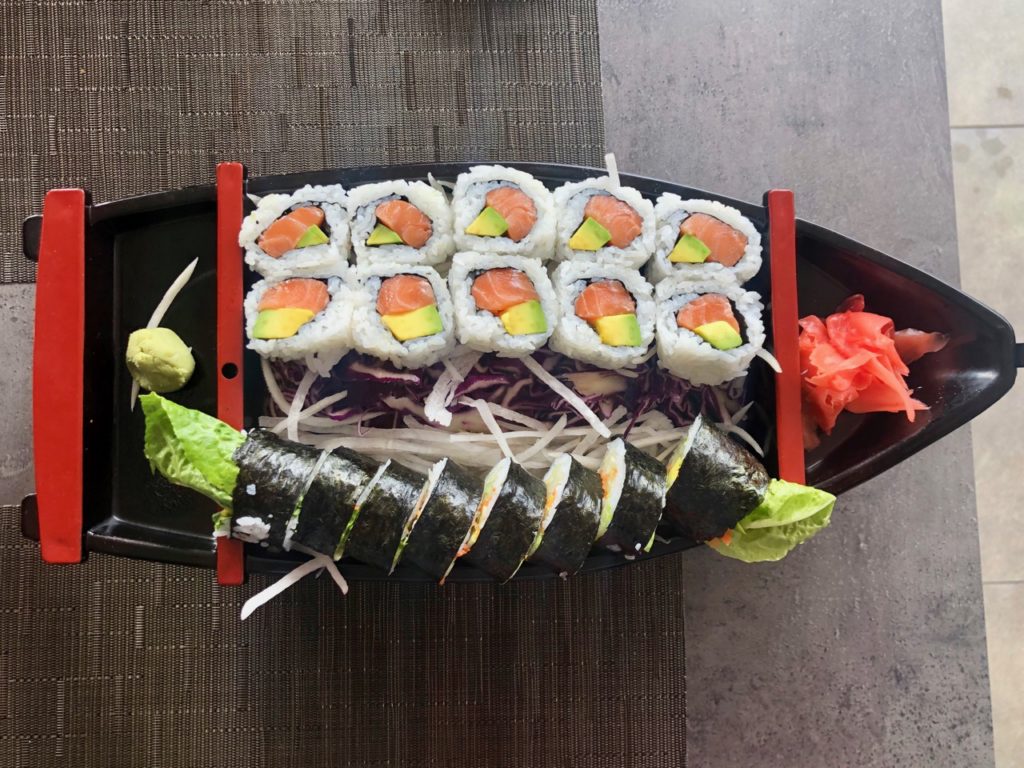

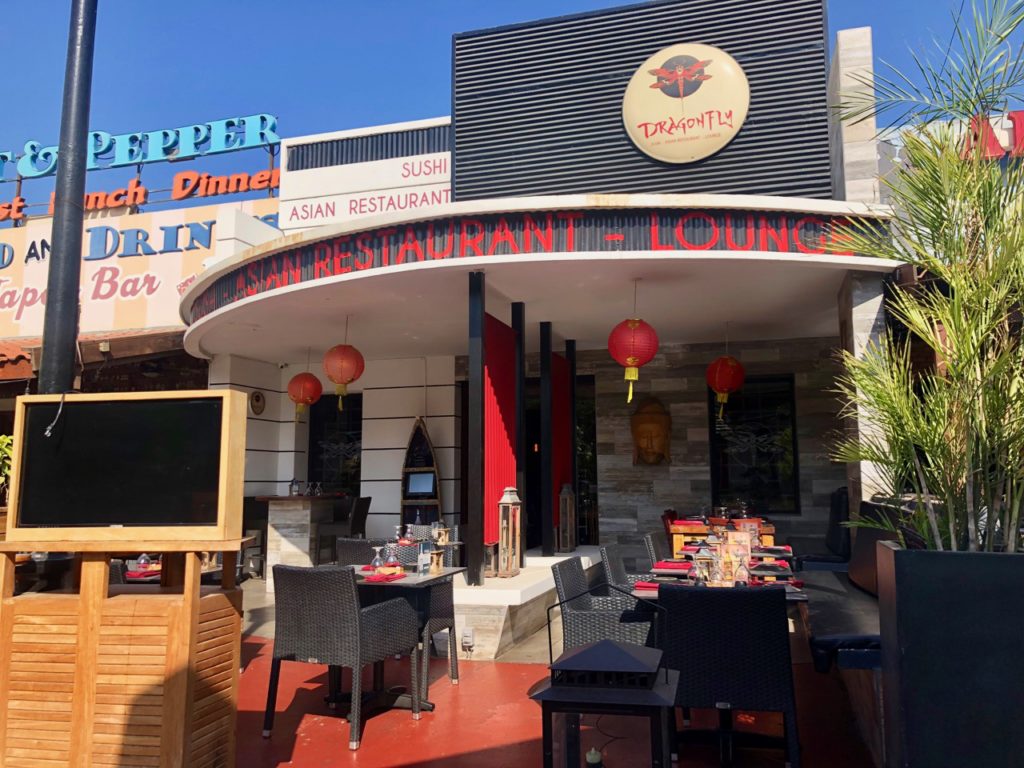
- Zeerovers – We visited this place for lunch and it was packed (meaning we had to wait in line for one hour). Since it was already pretty late (2pm) and we needed food, we decided to stick to the line. Oh boy was it worth it. This place was packed of locals (which is usually a good sign) and are selling fresh fish by the pound. When we saw they were cash only (an exception on the island as most vendors will happily take your credit card so you can accumulate even more points to travel for free) we were a bit worried as fish on the island can be pricey. We ordered 3 fish (2 amberjacks, 1 tuna), 5 shrimps, 2 plantains and 1 corn bread for a total of only Aruban florin (or just under 17 USD). That was definitely a deal. The place has a nice shaded area by the water where we sat while waiting for our food to come. The only cons for this place was that they use vegetable oil (something we try to avoid for health related reasons that we might talk about in a future blog post).

- Fishes and More – Fishes and More was the first restaurant we ate at once shortly after we arrived on the island. We tried their 3 courses menu which was really affordable (under 25 USD).

Recommended Grocery Stores and Markets:
If you are staying in Aruba for longer-term, then cooking at home is recommended to be healthier but it is also healthier for your budget than eating out every meal. If you are only in Aruba for a short vacation, then you will probably not need to go grocery shopping.
Unfortunately, Aruba doesn’t have a farmer’s market as far as we know. Most products are imported directly from the USA. We learned from talking with locals that the island has a small community of farmers but they currently focus their effort to feed the residents of Aruba so most of their food isn’t available in grocery stores. While this is great for the locals, as a tourist, you will end up buying produce at a premium since almost everything is imported.
However, we found a couple of supermarkets where we did most of our grocery shopping. We are only listing the ones that were walking distance from our Airbnb. Keep in mind that you will find more on the island.
- Super Food – This was the first place we went grocery shopping and it became our favorite. The grocery store is part of a larger plaza that has restaurants and other small boutiques. The store was relatively well provisioned with food from fruits, vegetables to breads, baked goods, cereals, ice cream, fish and meat. Don’t forget to ask for the Super Food card to be able to get the discounted price on products.
- Daily Fish – This small restaurant (next to Super Food) acts also as a fish shop which has a pretty good selection of fresh, locally caught fish.
- Ling & Sons (IGA) – Dubbed as “The Largest American Style Supermarket in Aruba”, this supermarket was similar to Super Food but much further away from our AirBnB (40 mins vs 10 mins for Super Food). The selection was relatively similar, yet we found the produce to be slightly more expensive.
Recommended Local Stores
- Aruba Aloe – There are a few locations in Aruba. We went there as we needed some environmentally friendly sunscreens for our body and this company offers great options at a reasonable price compared to conventional sunscreens.
- Living Food Aruba – Thanks to our host, we had the chance to spend an entire evening with Tom and Amada and we were very grateful for this opportunity. We learned a lot about their story (they are a lovely American couple who recently settled in Aruba) as well as the story of the island. On top of that, we were able to get what is BY FAR the best (& most affordable) Kombucha and Sauerkraut you can find on the island. And I think you can trust us as we are addicted to trying fermented food wherever we go.

Recommended Sights and Activities in Aruba
Most of the activities on Aruba are taking place on the west end side of the island while the sights are pretty much everywhere. The north west is where most of the hotels/accommodations are. The south west is still behind but was back in the 1980 the main point of commerce as this is where the oil refinery was. The east side of the island is more desert (they actually have one national park) and the beaches are quite dangerous due to their exposure to the ocean. Due to this specific configuration of Aruba, we recommend renting a car only for just a couple days to hit the sites that are not either accessible by foot or by public transportation.
Note: There are no free walking tours in Aruba.
Here are the places we recommend to check out:
- Eagle Beach – This was our favorite beach. It is also the top 3rd beach in the world (according to TripAdvisor) and we won’t disagree. It stretches over a mile, has white sand and is pretty empty most of the day. And since it’s the closest beach from our apartment, it makes for a great morning stroll in the sand to start our day. (Cost: FREE).
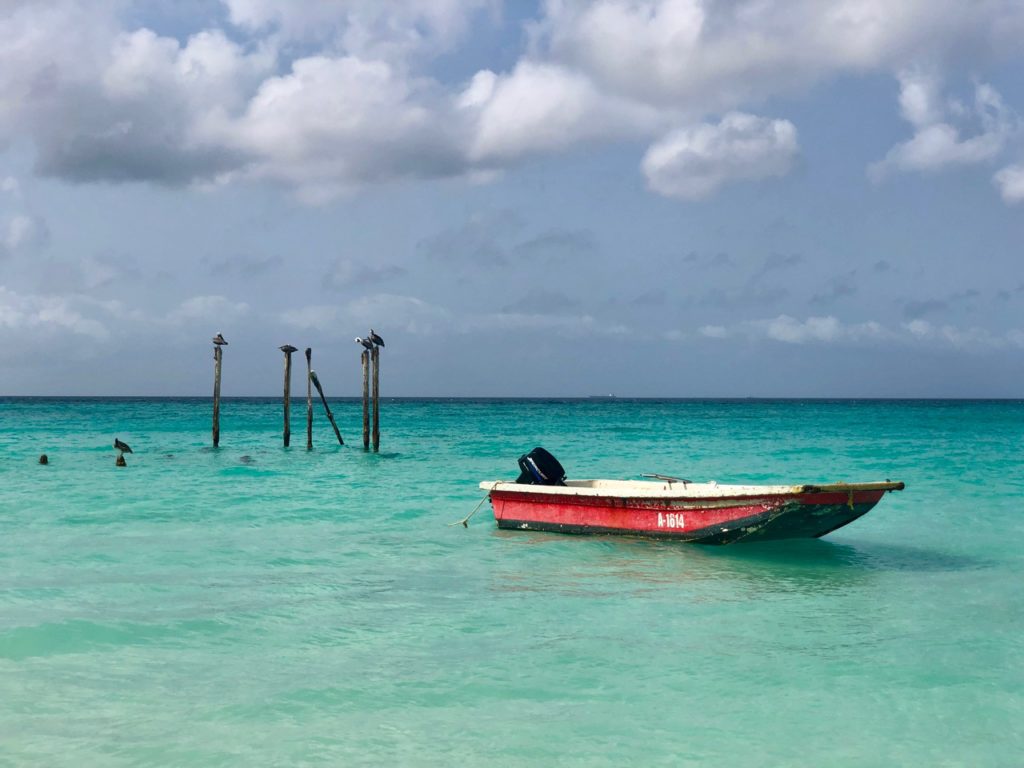
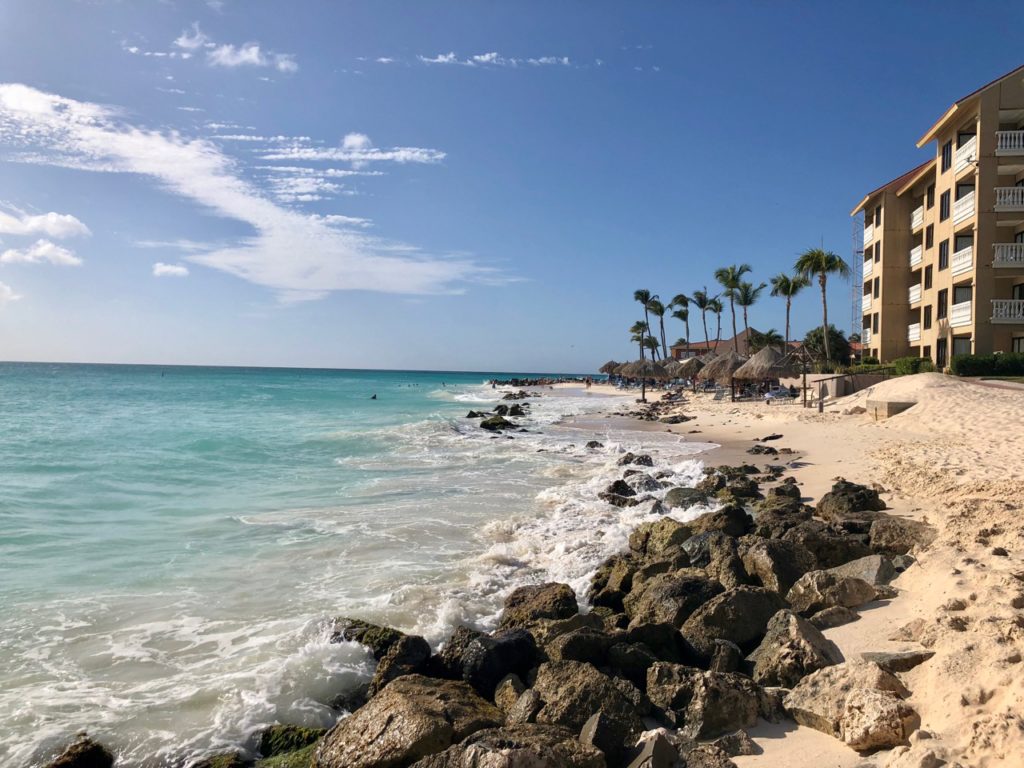
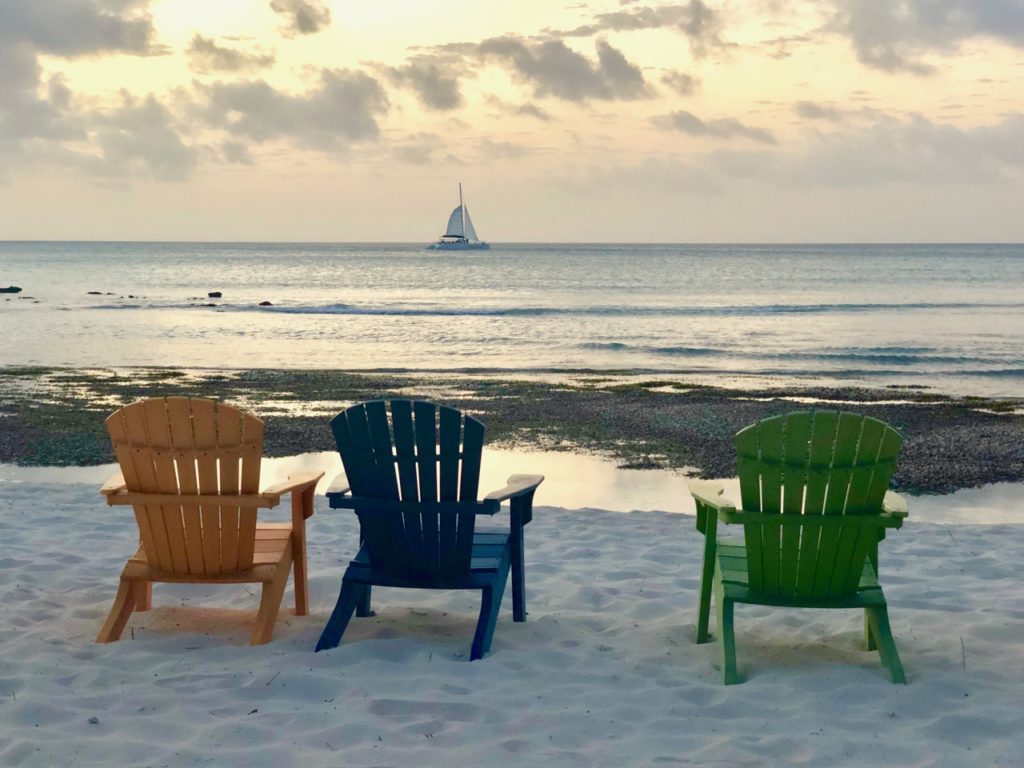
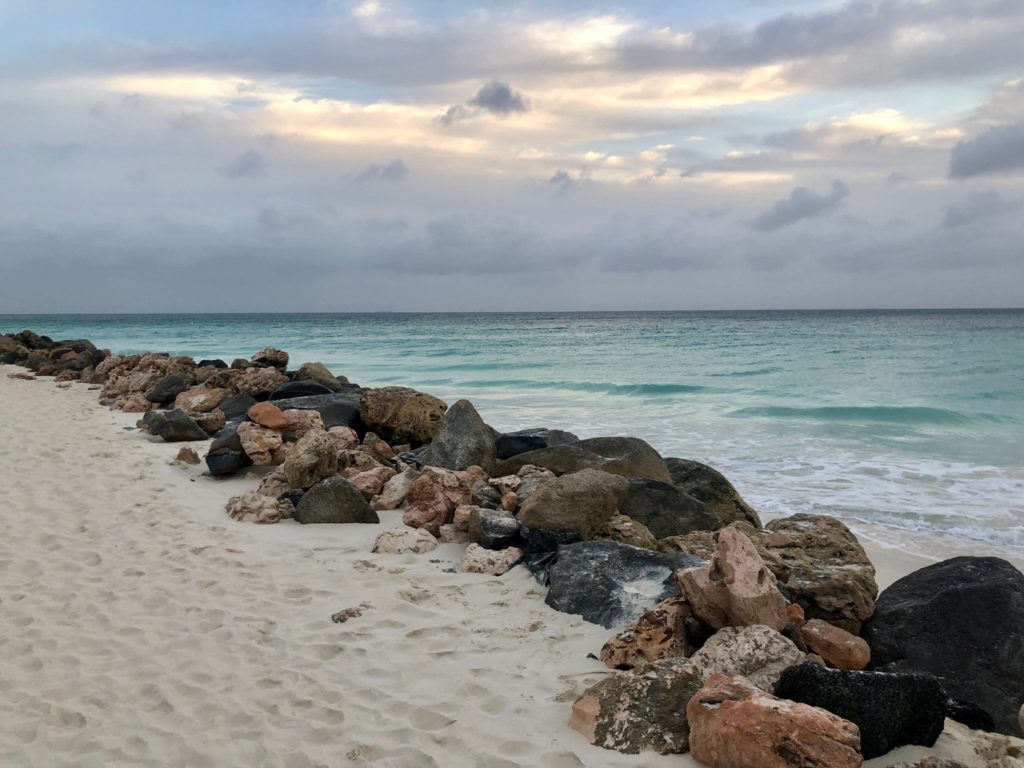
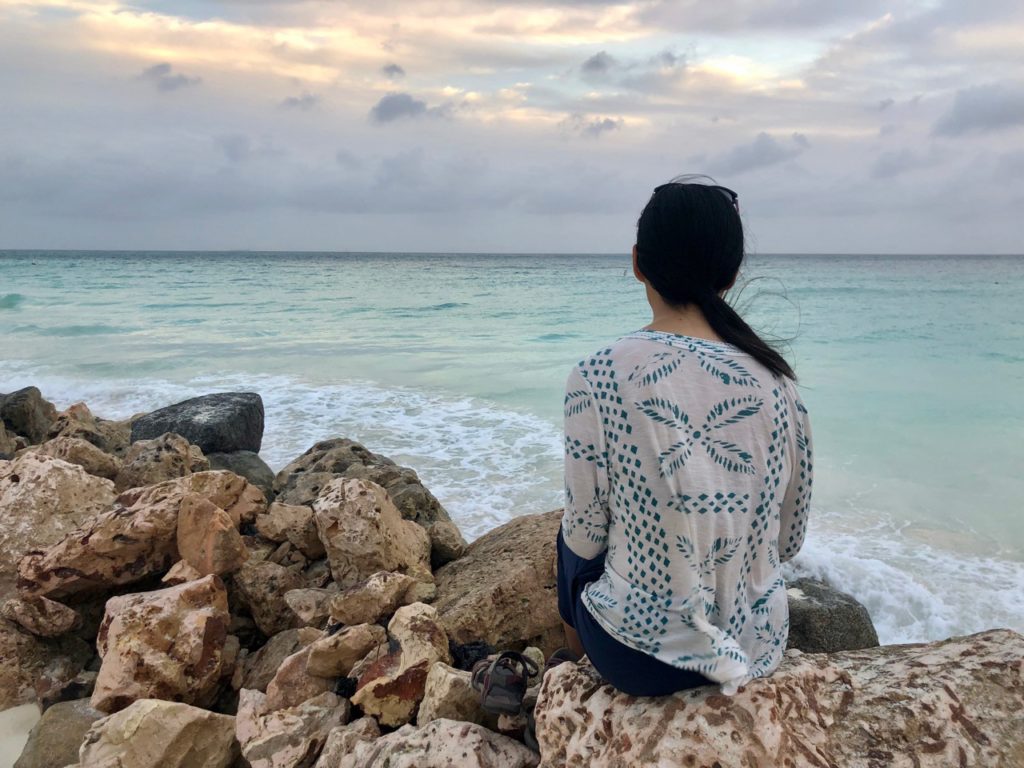
- Mangel Halto Beach – This is the most secluded beach of Aruba we found. It has nice groves and fishing birds which makes the place pretty relaxing. We came twice and it wasn’t as crowded as some of the other beaches you can find on the island. Should we keep it a secret?
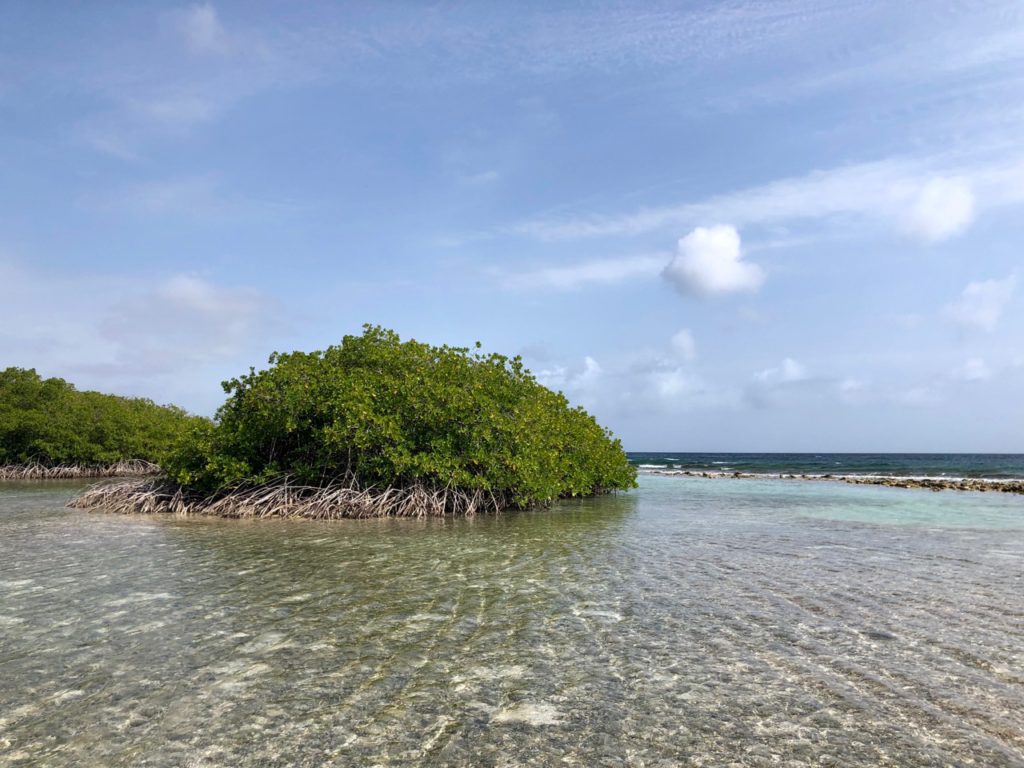
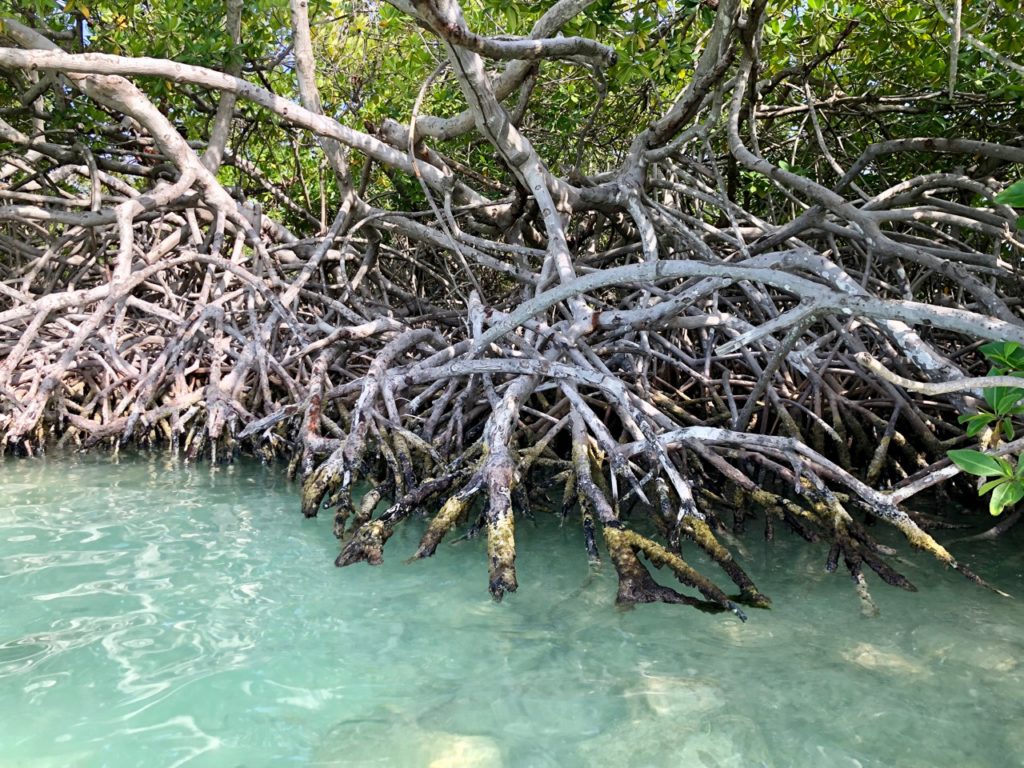
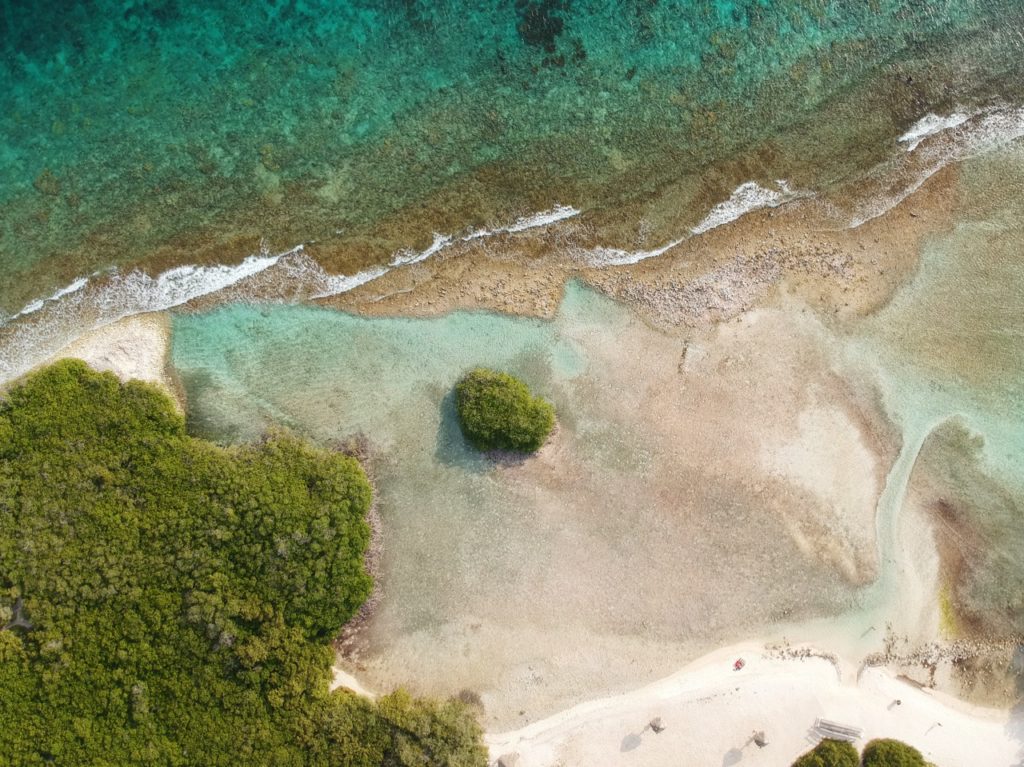
- Sunset – Since a picture can be worth a thousand words, here are a few to explain why sunset are worth seeing in Aruba.
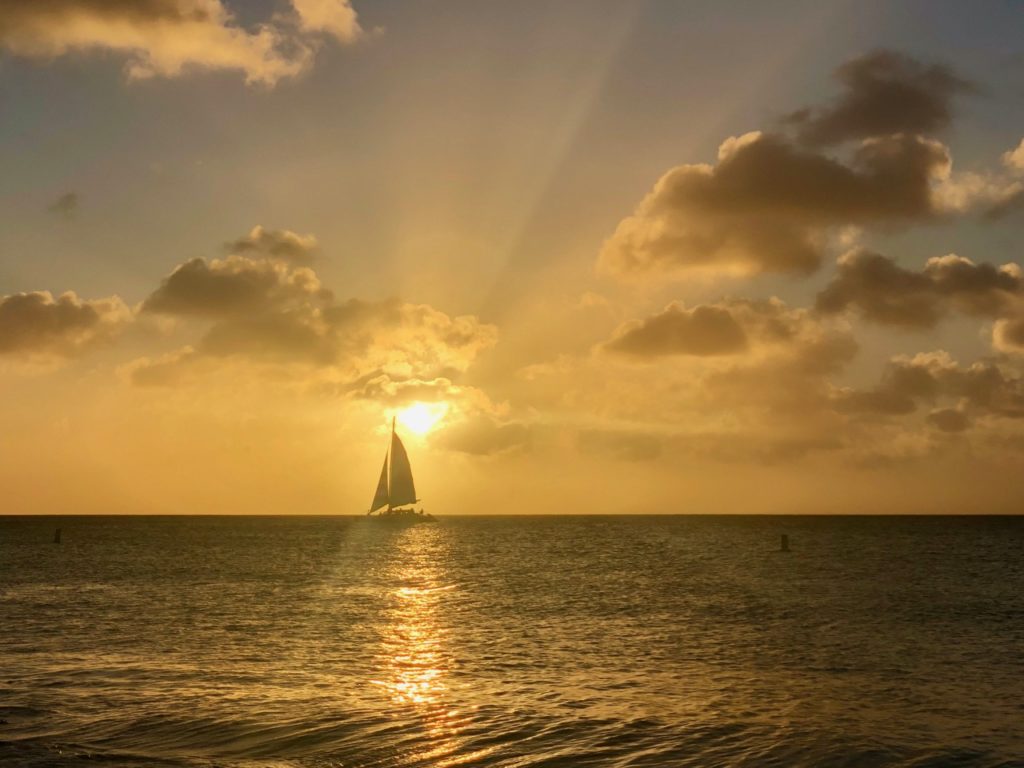
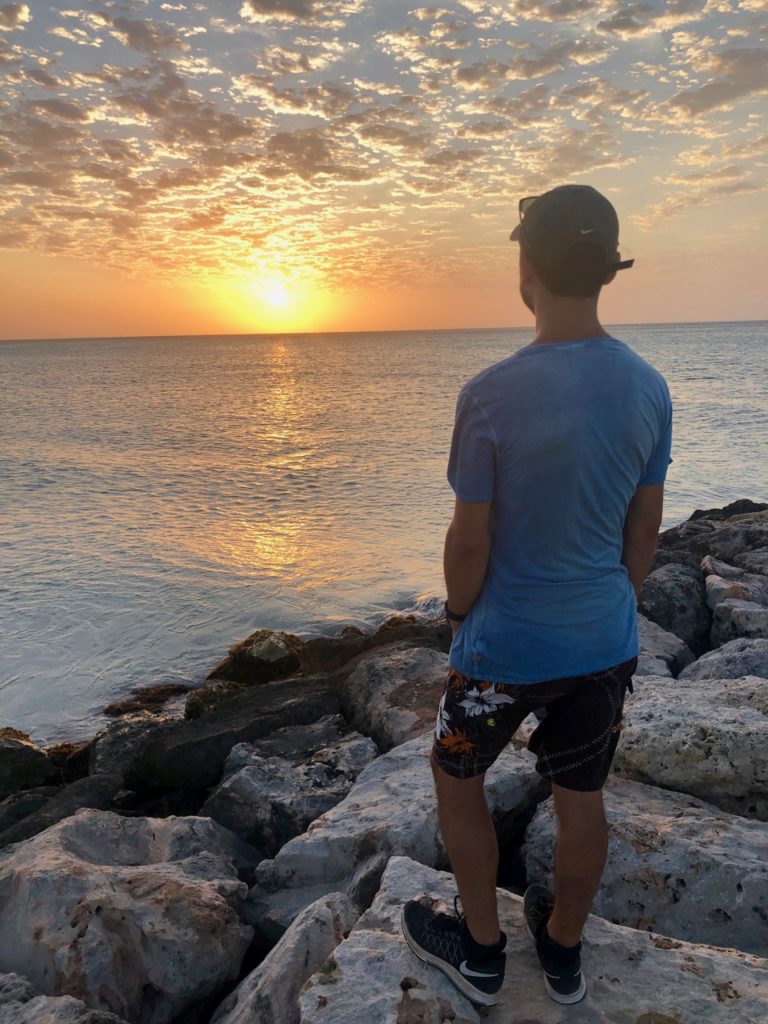
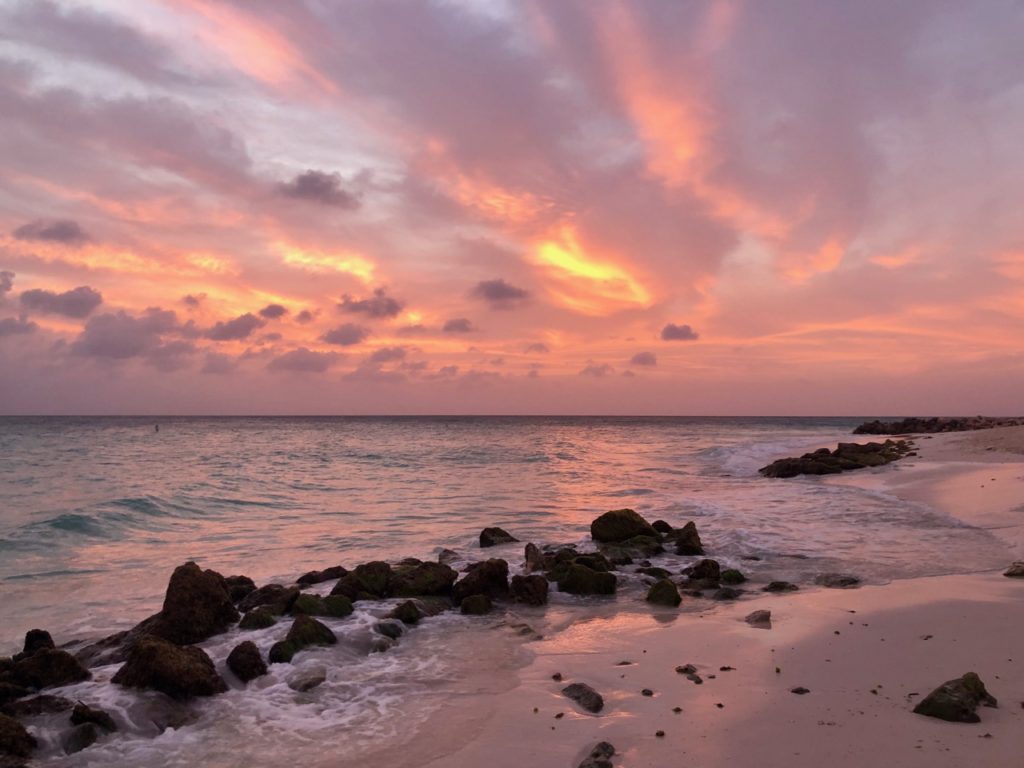
- Carnival – High season in Aruba overlaps with the carnival season which lasts from Jan-March. People in Aruba love to party and the carnival is a great manifestation of this. Beautiful people dancing (& drinking), wearing gorgeous costumes to the sounds of local rhythms. We attended two of the main carnival parade and they were really amazing. (Cost: FREE).
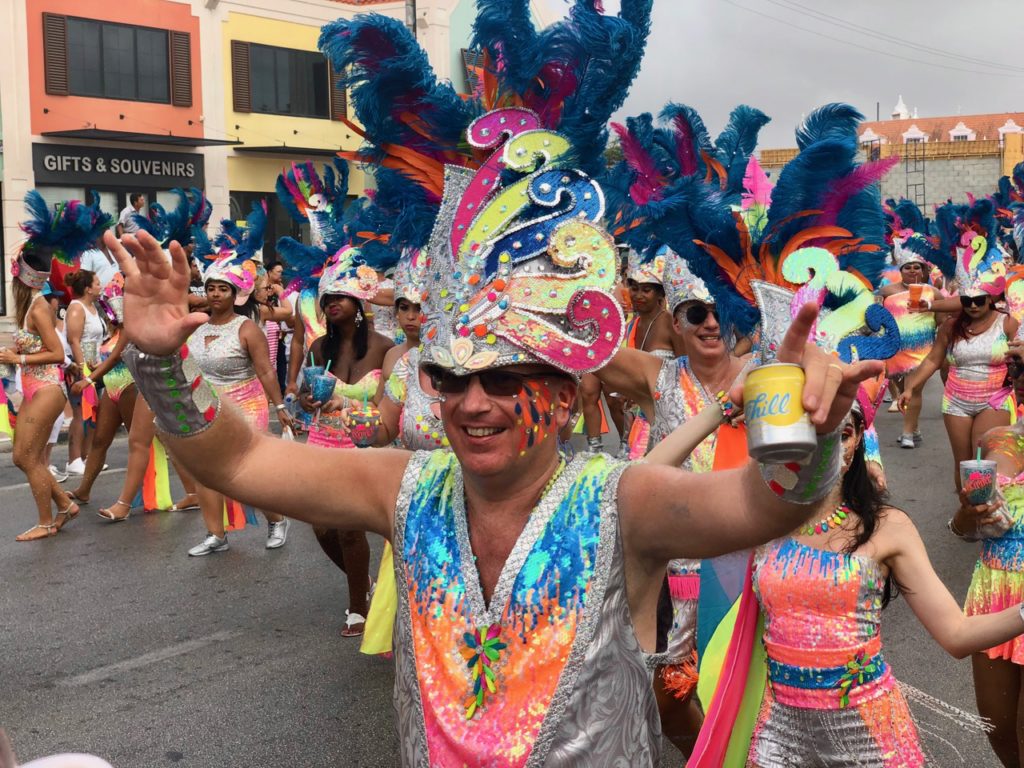
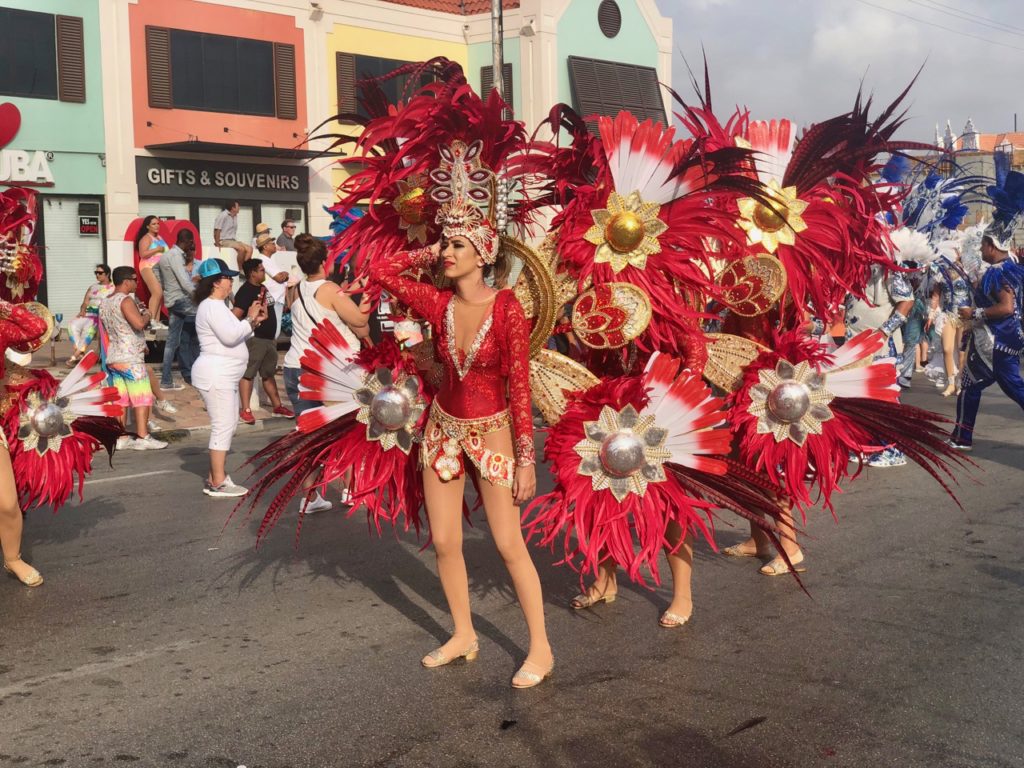
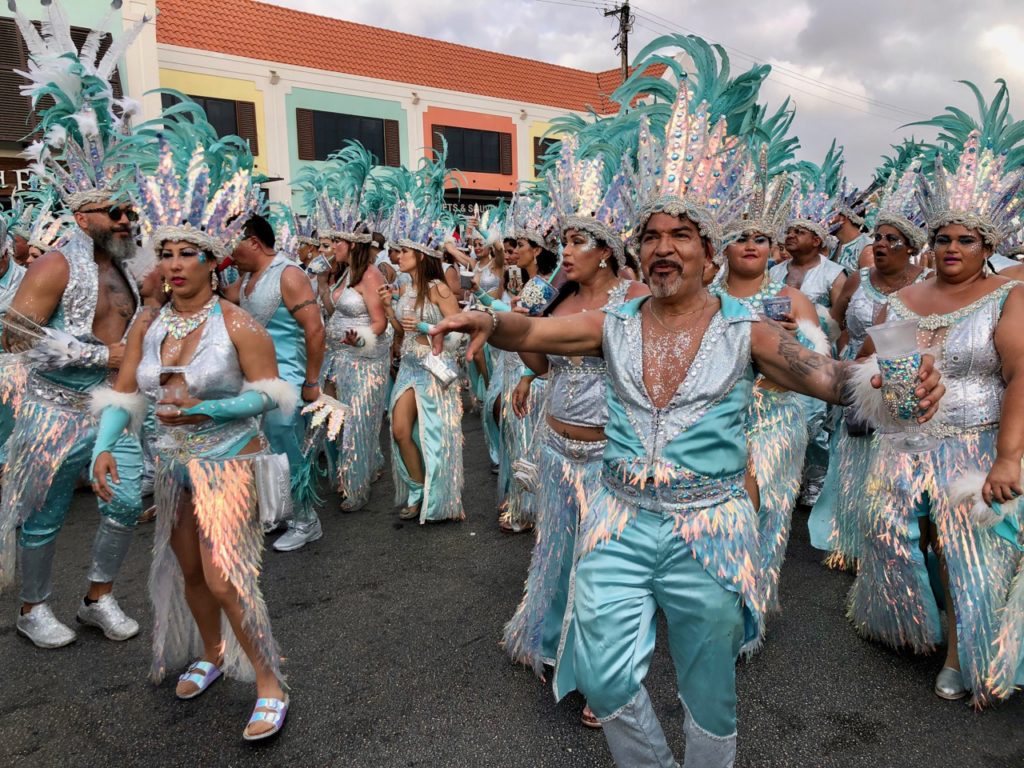
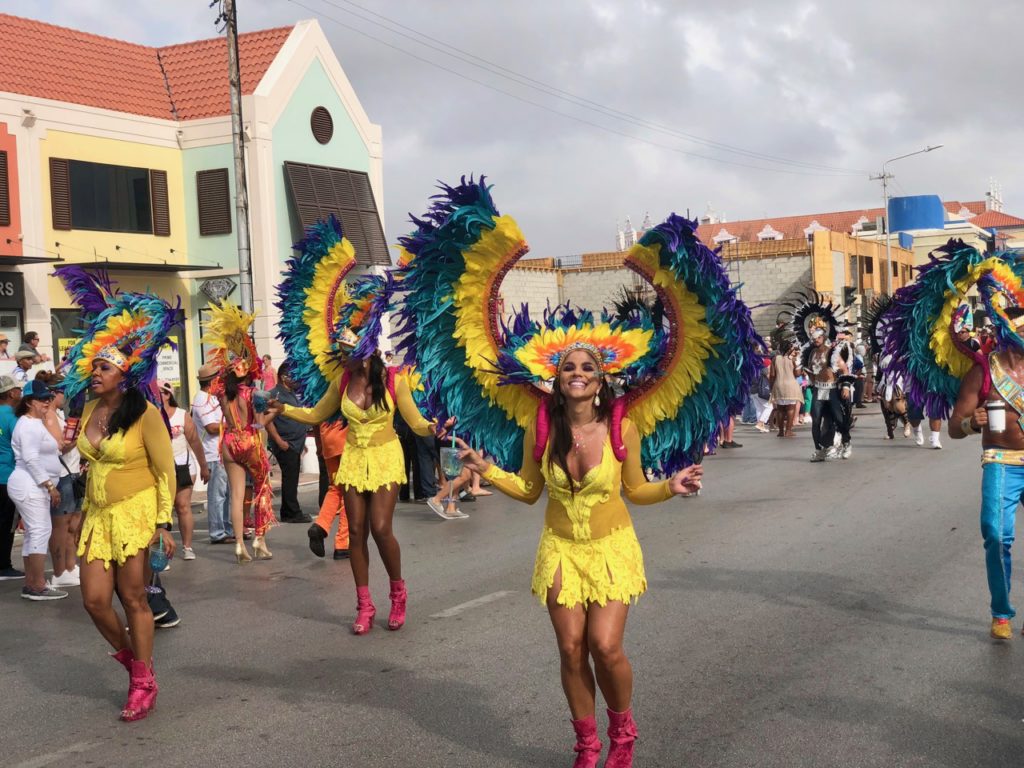
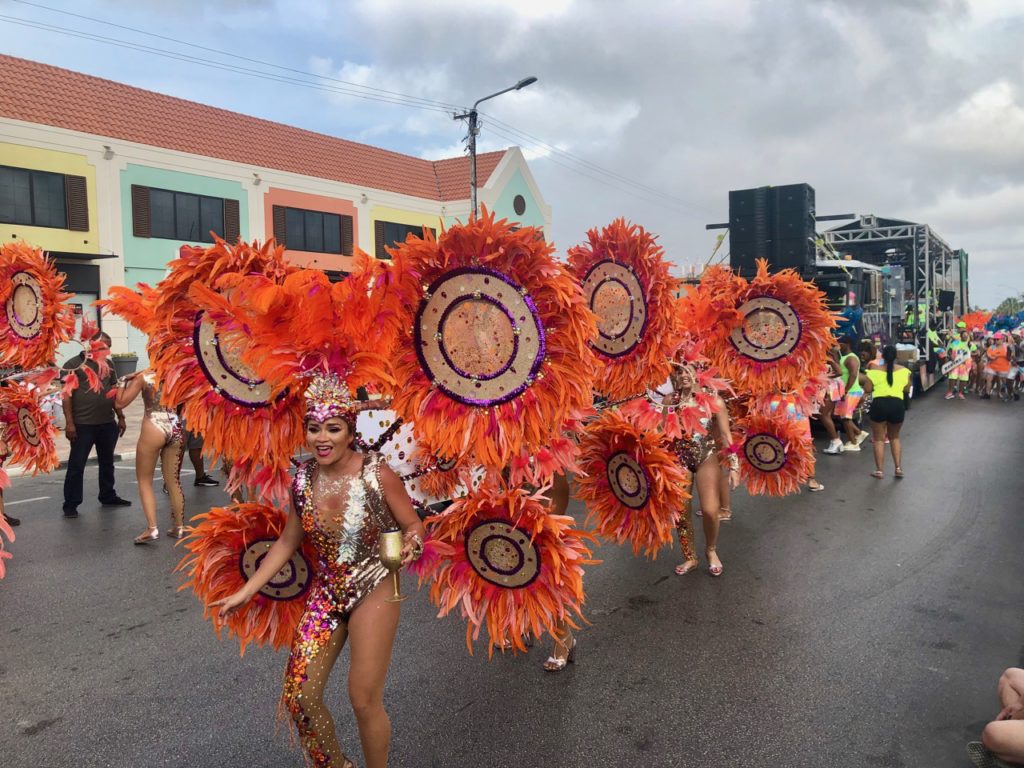
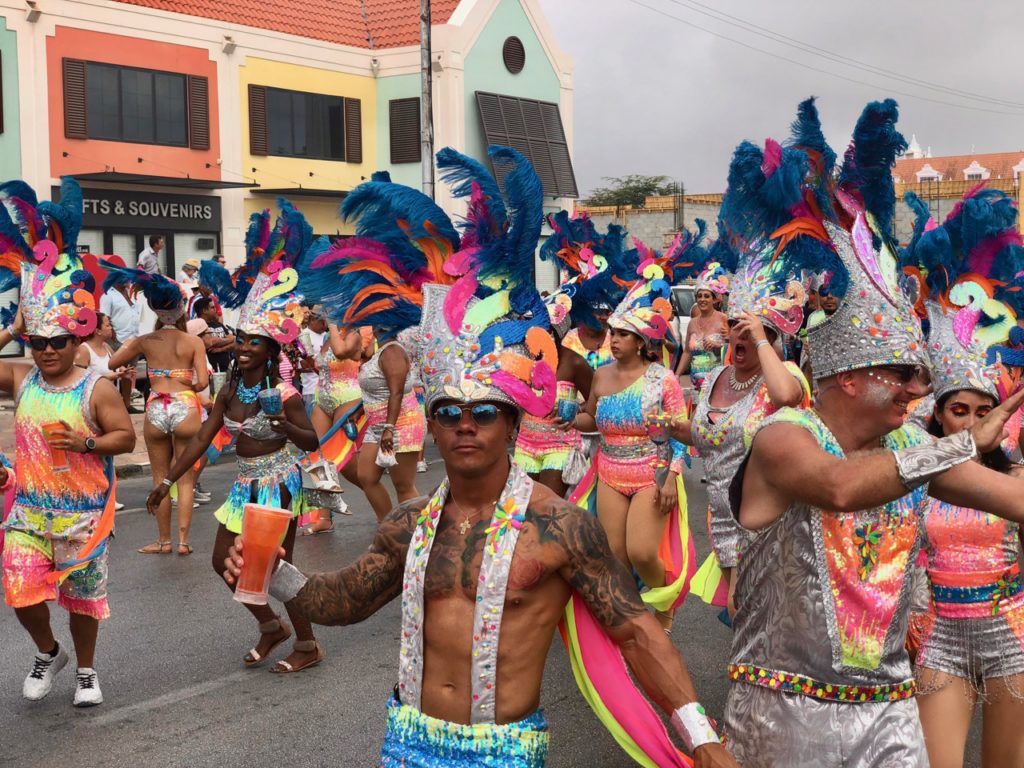
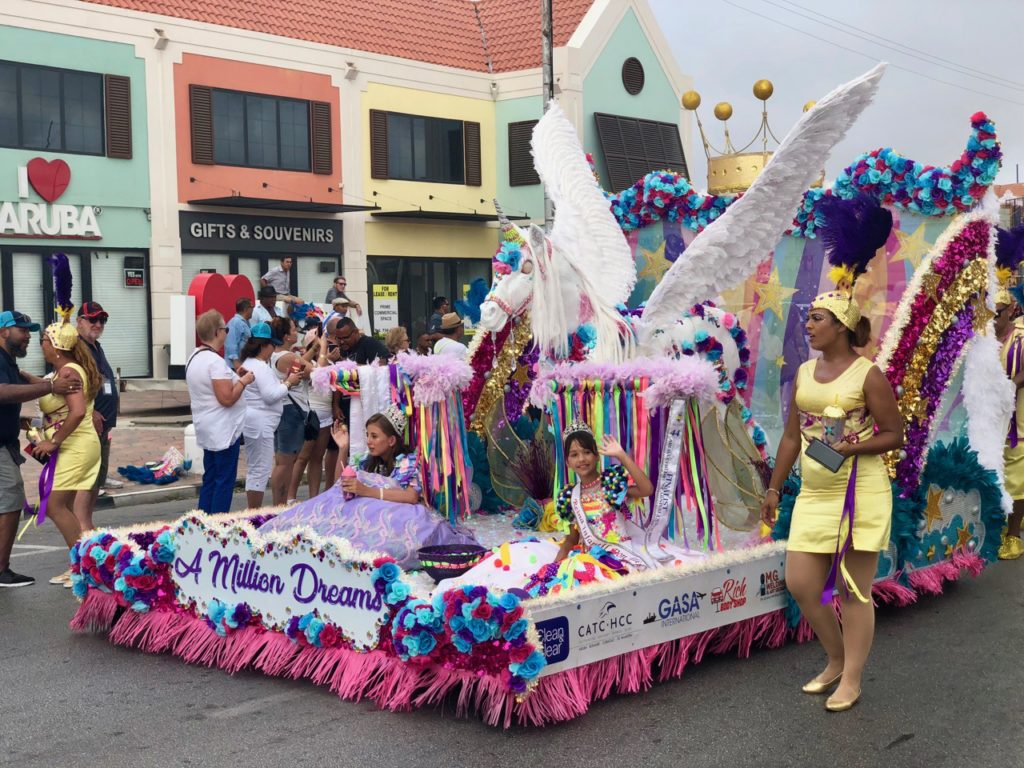
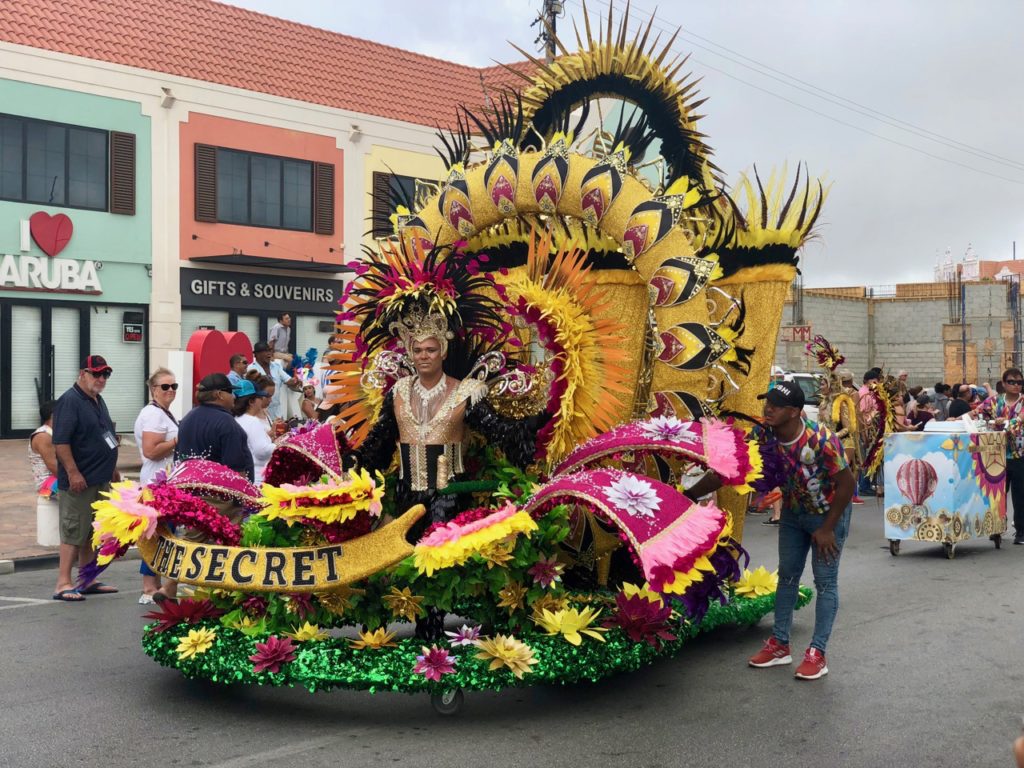
- Natural pools at Conchi beach – We drove + hiked to get there by following this great itinerary. This saved us from joining a busy tour and gave us the ability to reach the pool before anyone else (usually 10am). Important note: the ocean can be really strong at this site so make sure to evaluate the situation before going to this natural pool. If you want to be safe, you can wait for the first load of tourists to come as they go with a guide which usually assess if the weather is good for people to go. (Cost: Entrance fee of Arikok National Park: 11 USD per person).
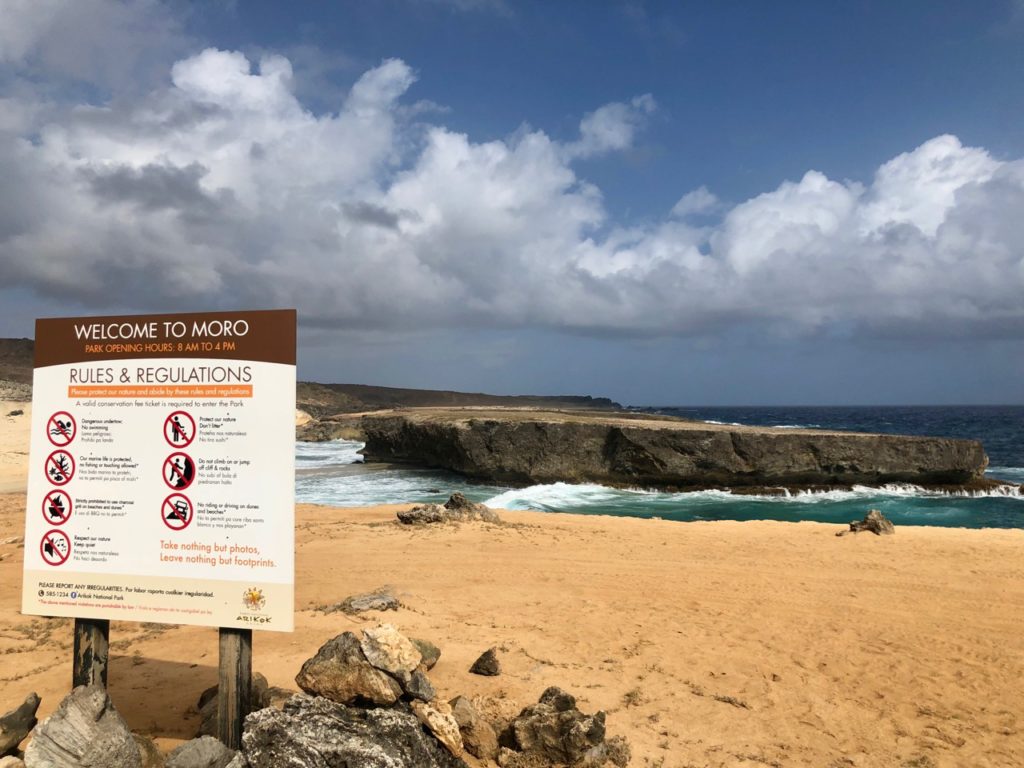
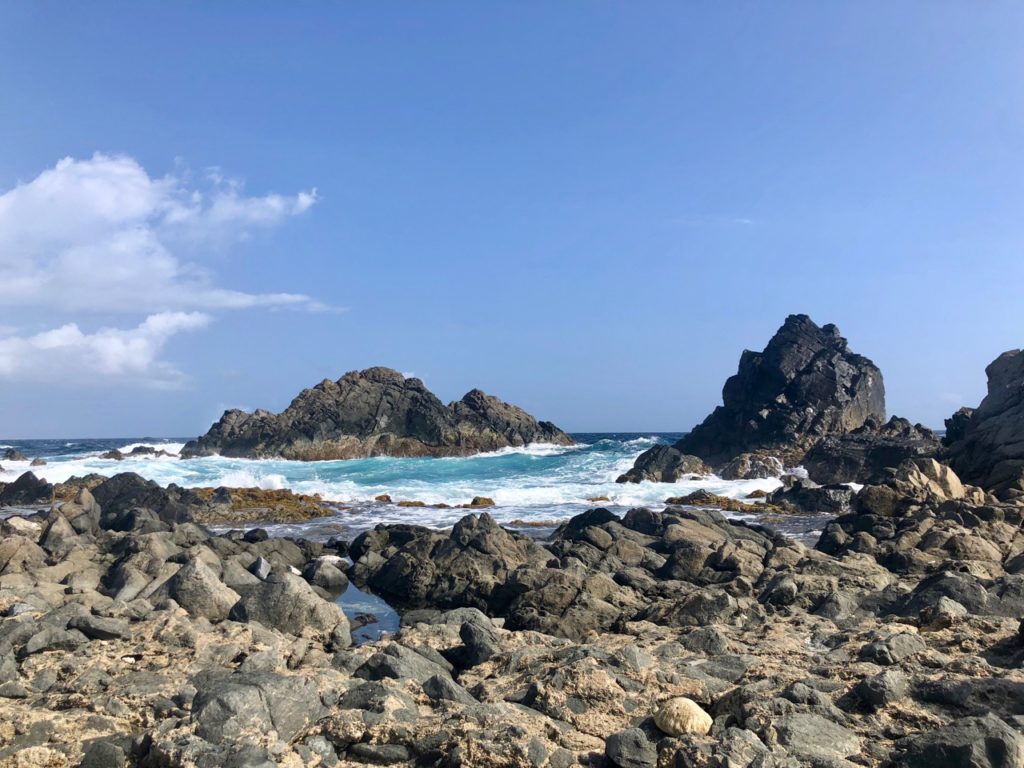
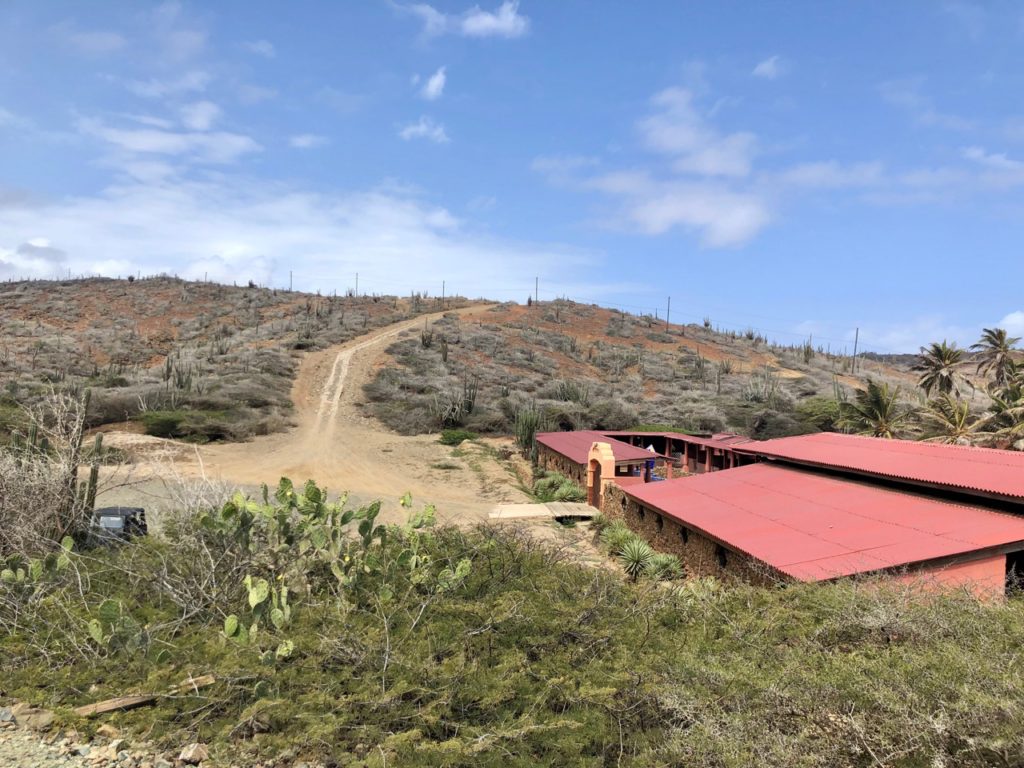
- Arikok National Park – After the natural pools, we drove to this park to explore its caves: Fotein & Guadirikiri. The first cave is pretty small and it seems that this is where most of the tourists stop. The second was massive and the best one so make sure you can stop there. (Cost: Entrance fee of Arikok National Park: 11 USD per person).
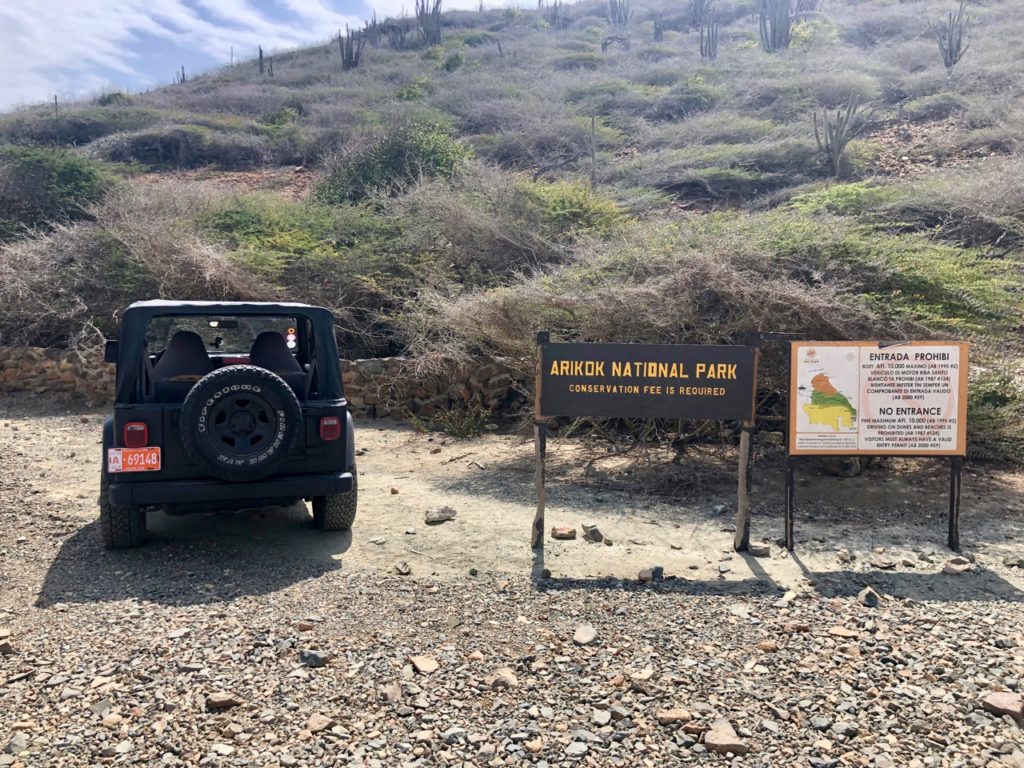
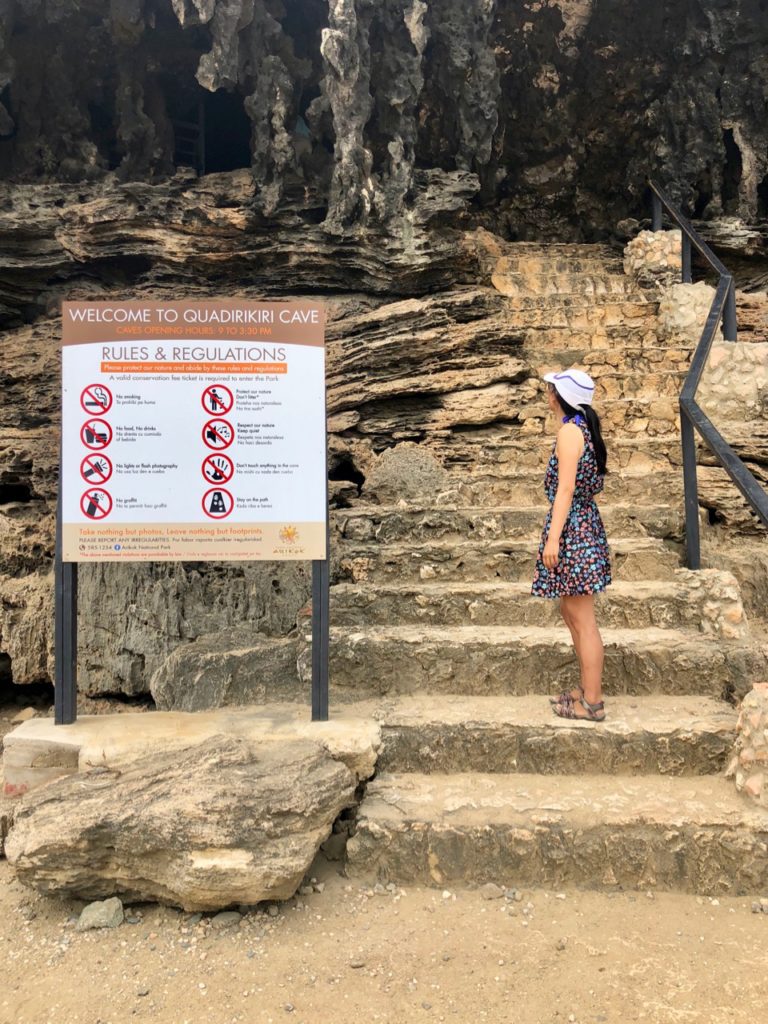
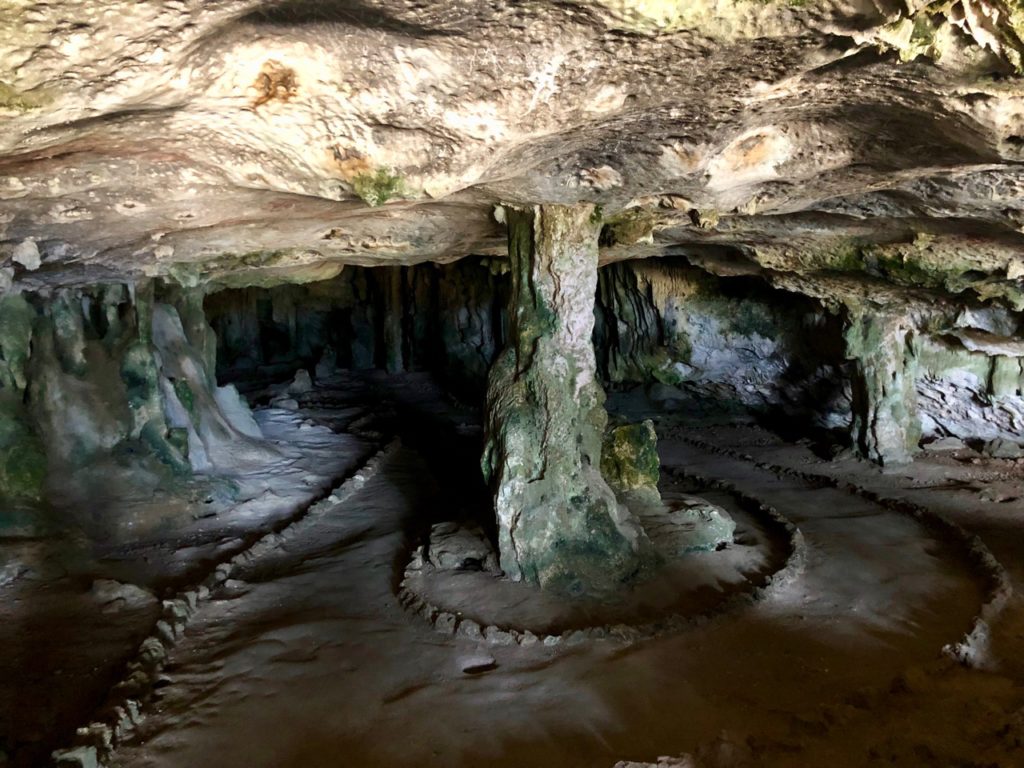

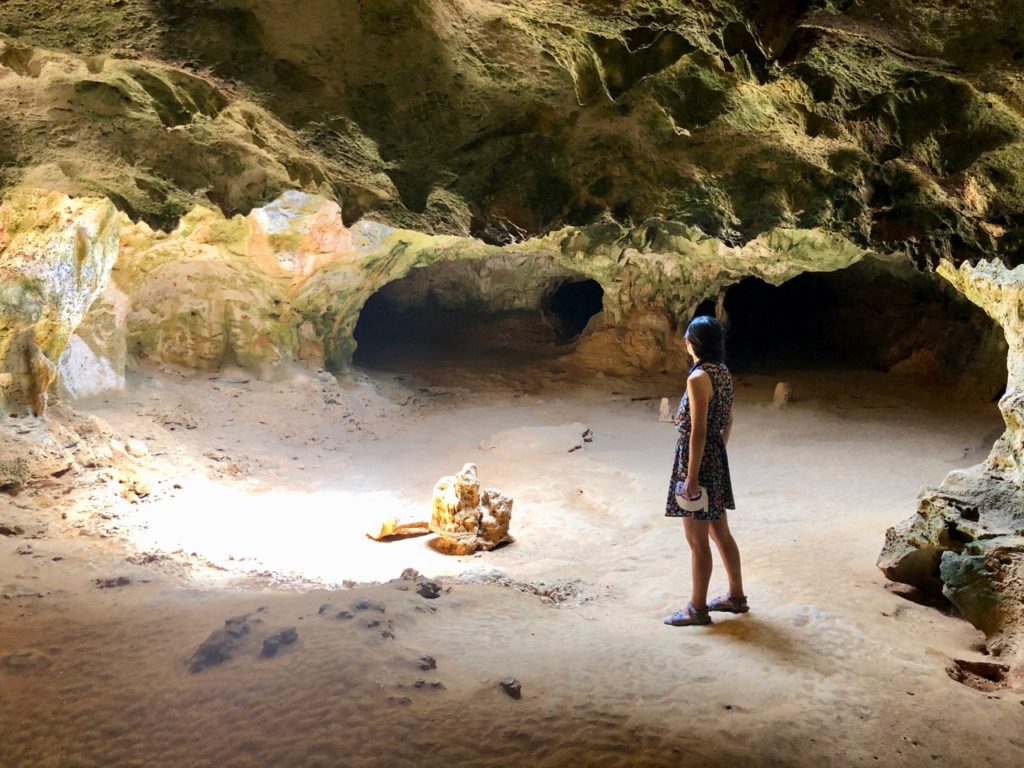
- Arusun snorkeling cruise – We highly recommend booking the afternoon cruise on the Arusun. We boarded a 65-foot catamaran (The Arusun) to see the Antilla shipwreck (a 400 foot freighter) and the beautiful Boca Catalina Bay with shallow calm water and plenty to see. The staff was amazing and so were the drinks. (Cost: 45 USD per person if you book online which is a great value knowing that renting snorkel gear rental alone is $25).
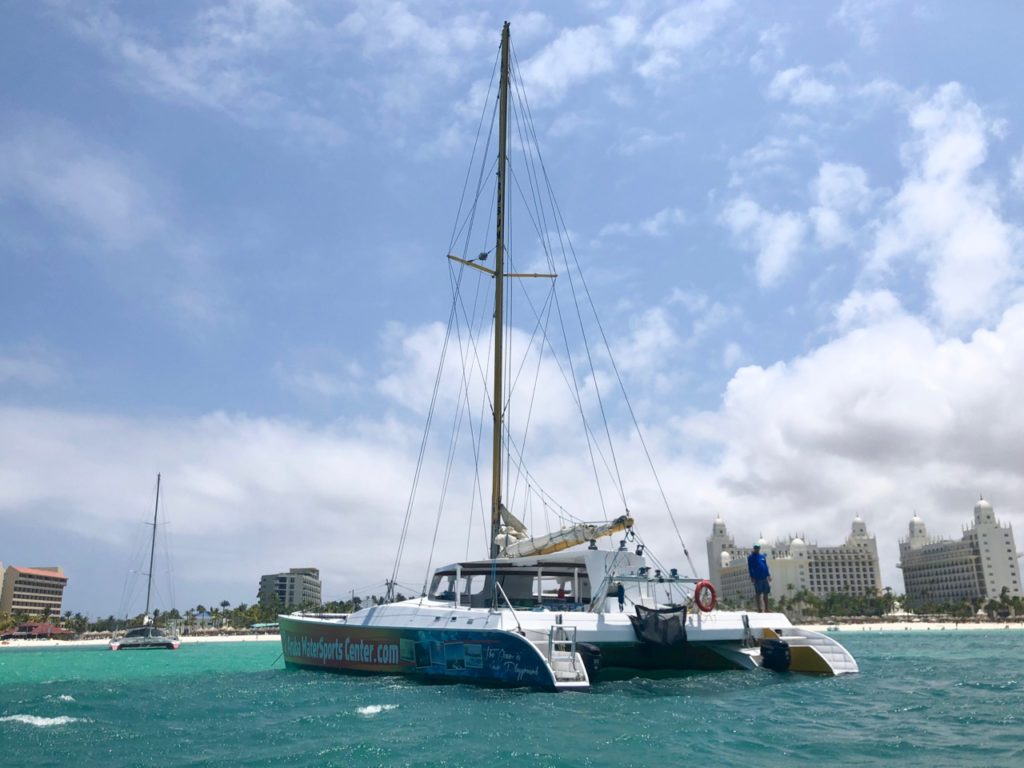
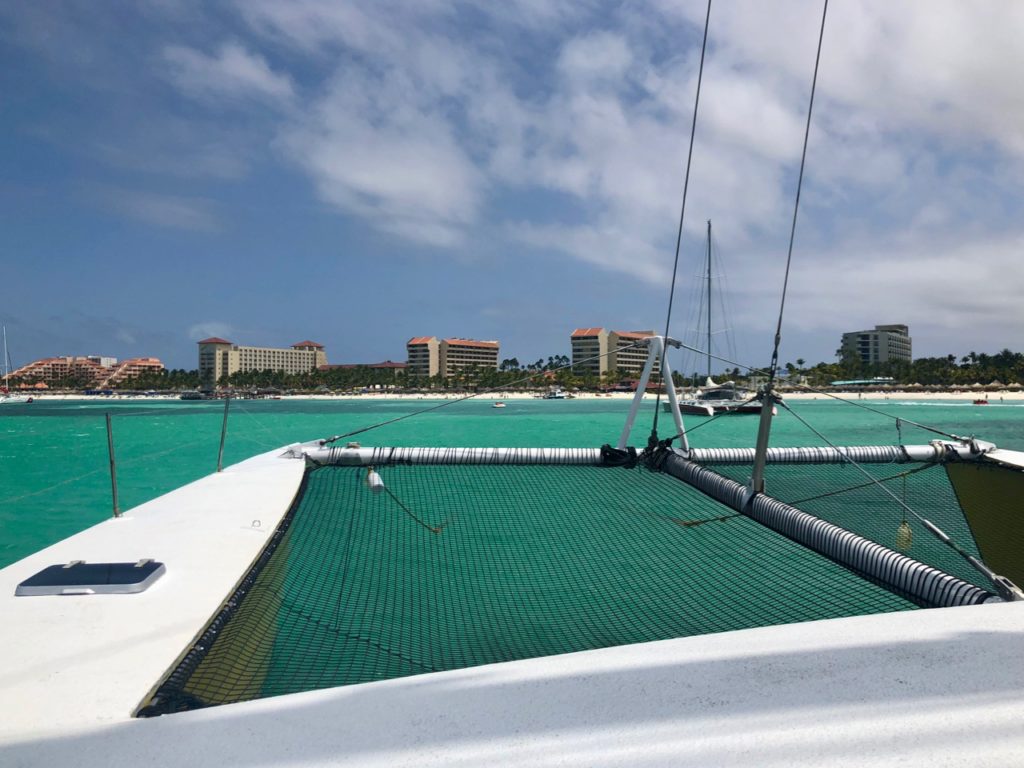
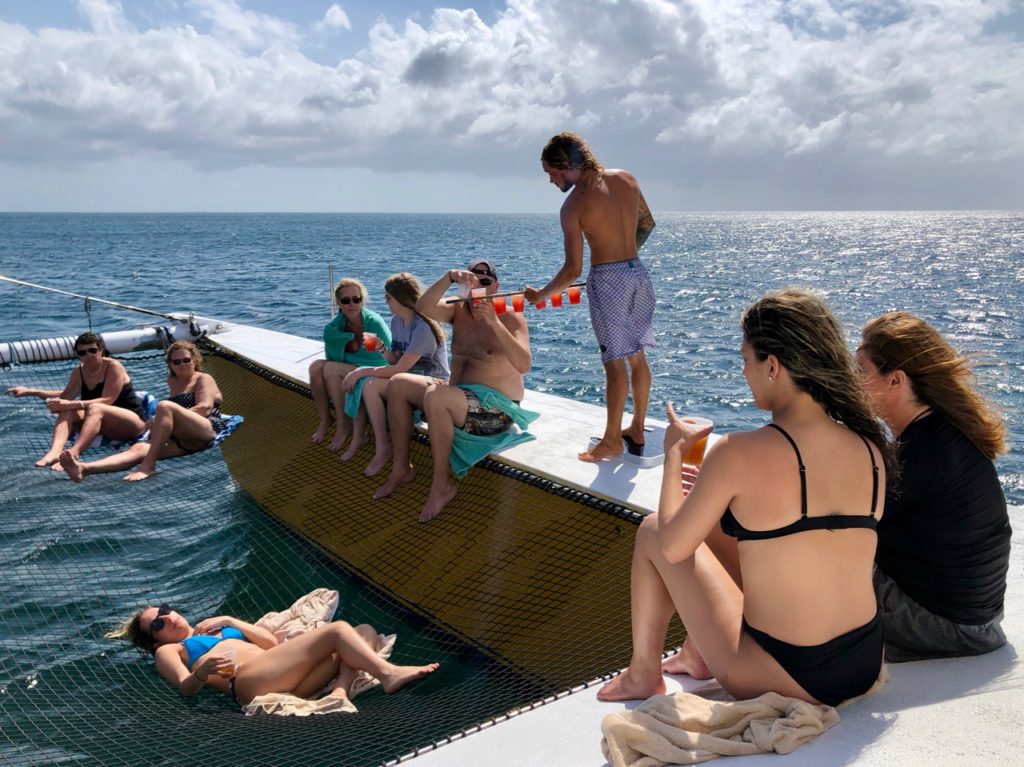
We didn’t have a chance to try the places below but they seem worth checking out:
- Eduardo’s Beach Shack – Mrs. Nomad Numbers wanted to check out this place because they have great Vegetarian/Vegan options, which include The Coco Whip, which is made of coconut ice cream that is entirely vegan.
What to Avoid in Aruba
- Baby beach – This beach was recommended by one of the restaurants we ate at. While the beach is protected from the waves and has some turquoise color, it isn’t what it used to be 20 years ago. It is now getting really crowded and pretty developed. If this beach is out of your way, don’t feel bad for missing out. You would have a much better time at Eagle Beach or even at Mango Alto beach that we mentioned earlier. Note: Mrs NN disagrees a bit on this with my assessment so take this with a little pinch of salt 🙂
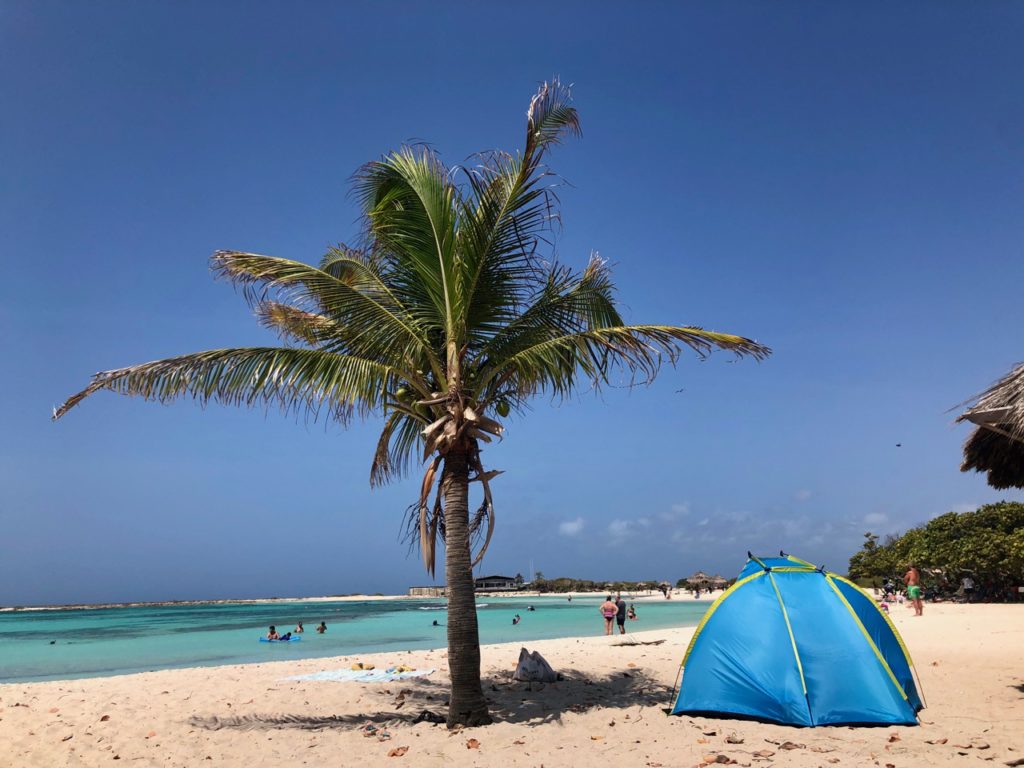
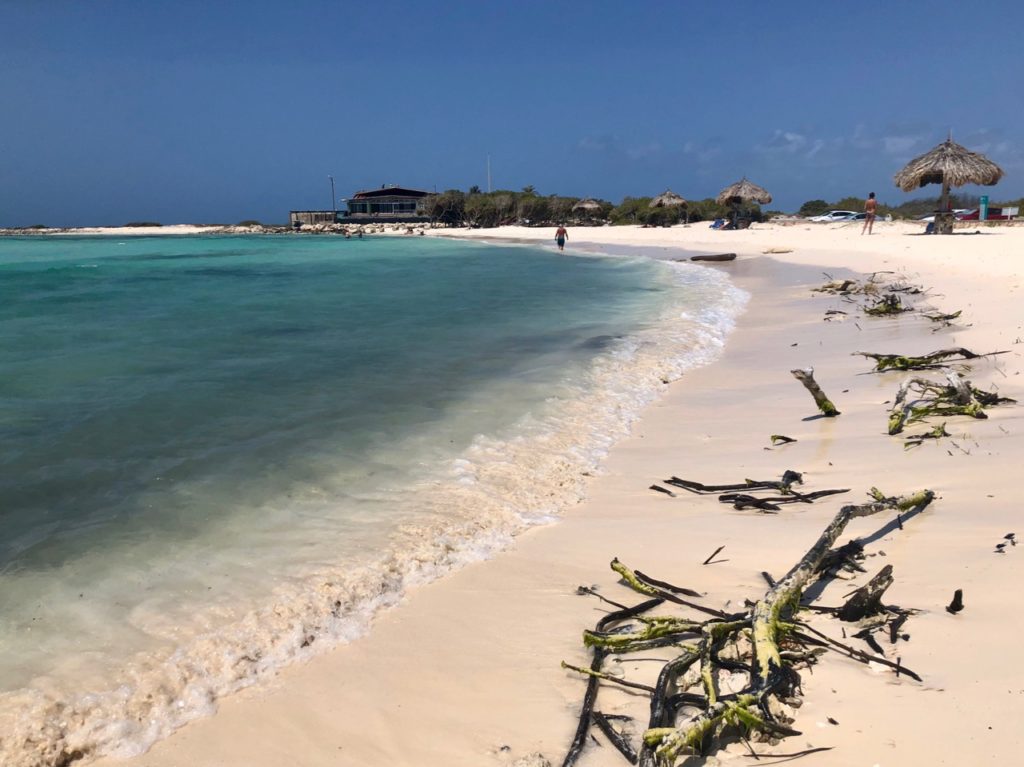
- Palm beach – This is the main beach on the island that is next to the most high rise hotels. Unless you like crowded beaches, just skip it and check out Eagle beach instead which is much nicer and quieter too.
- Going to the natural pool with a tour – Instead of taking a tour which is really crowded and costs north of 100 USD per person, go check this natural sight on you own. Rent a car and follow these great instructions to do it on your own and beat the crowds. Just make sure the ocean is safe before getting into the water.
Cost of Living in Aruba as Nomads
TL;DR; $47 per person and per day as a couple, or $1,397 per month per person!
With our previous trips to Montreal, Quebec City, Puerto Vallarta, Mexico city, Oaxaca City and San Miguel de Allende our average monthly spend per person was around $32 / person / day (Excluding cost of getting in & out). As expected, Aruba was well above this average with a daily budget of $47 / person / day for a monthly budget of about $1,400 per person.
For this budget, we rented a car to explore the island for a couple of days, we also extensively explored our area by foot since things are pretty walkable near our area, including seeing the carnival. We ate out about once a week and regularly went grocery shopping to enjoy some nice dishes we made in the kitchen of the AirBnB. We spent copious amount of time relaxing by the beach every day. And we did all of this while staying in an apartment located just a few minutes away from the best beach of Aruba: Eagle Beach that provided us with amazing sunsets each evening. How did we manage to spend within this budget? Well let’s look into each main budget category in more detail.
Note: If you are curious about how we spend our money, check out this article where we explain our decision making process.
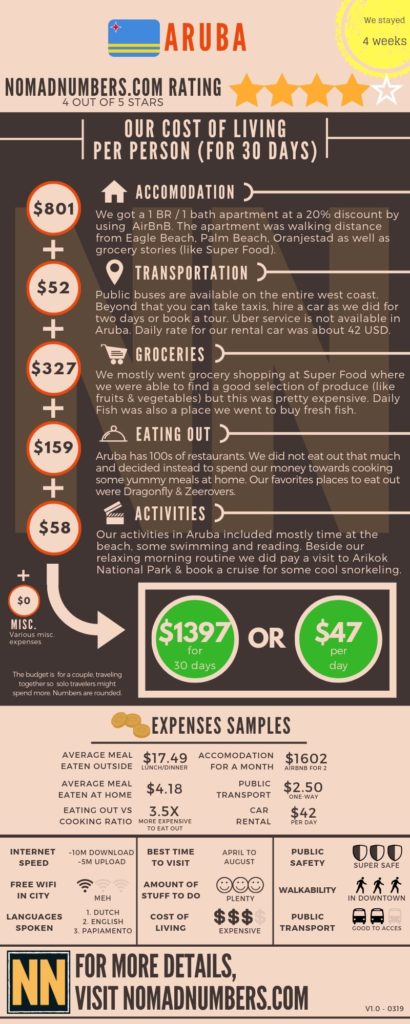
Accommodation: $26.70 / person / day
(OR $801 / person / month).
Accommodation is one of the most expensive parts of our budget even as slow travelers. In Aruba, which is an island destination, a night for two people at a hotel can easily cost 300 USD. Instead, we decided to leverage some of our own Airbnb tips to score a 1 bedroom / 1 bath apartment with a 20% discount (letting us save $350 from the regular price).
👉 You can check out our Airbnb rental listing here.
The apartment was walking distance from Eagle Beach, Palm Beach, Oranjestad, and Super Food which is where we ended up spending most of our time.
One of the highlights of our apartment was really our host Monique. She was really sweet and was always available to us for anything. We ended up meeting her entire family who helped us get in touch with some local residents of Aruba to help us find the best Kombucha and Sauerkraut on the island.
⇒ In total, for the length of our say, the 2 of us spent $1,549 on this apartment for a total of 28 nights.
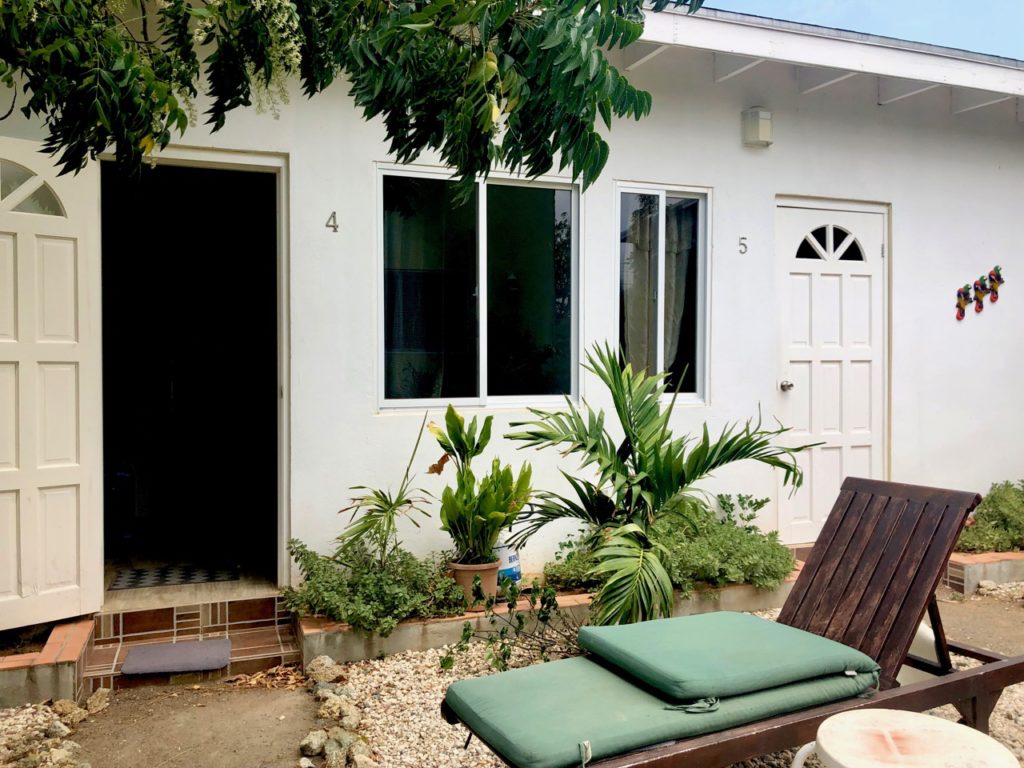
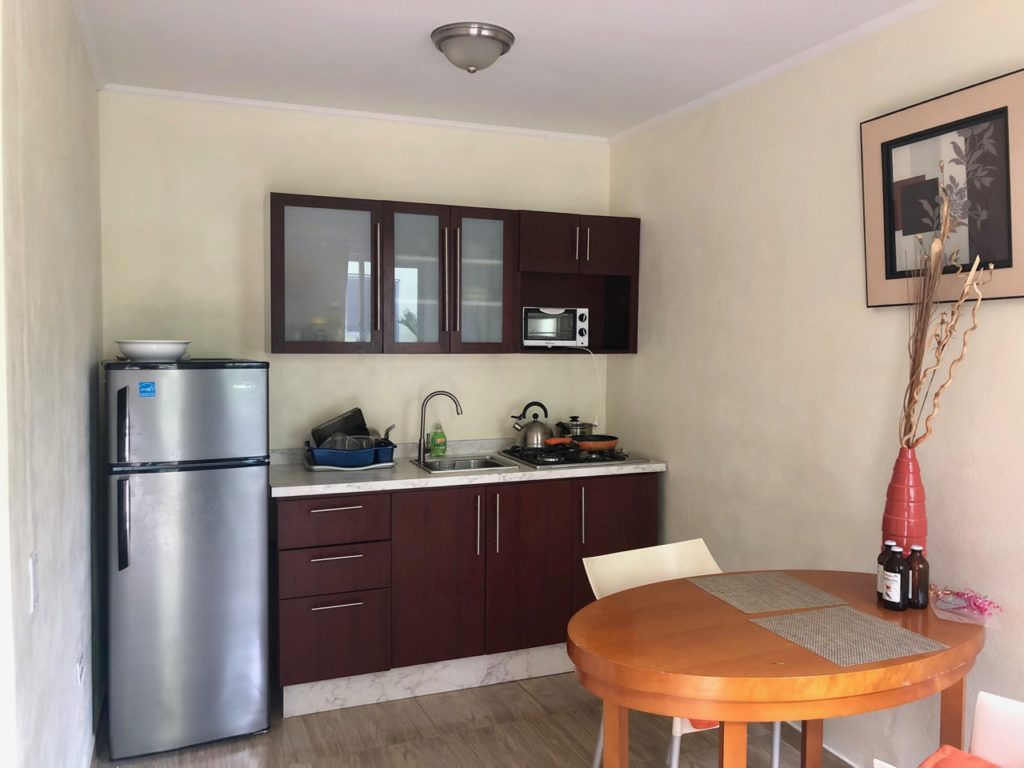
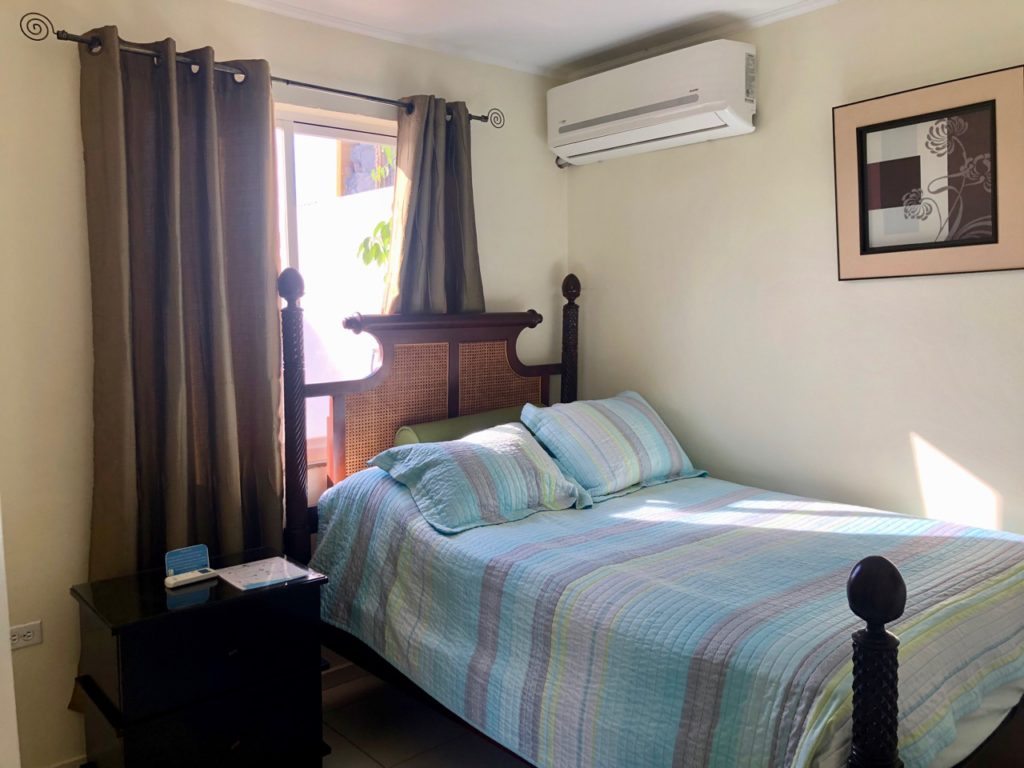
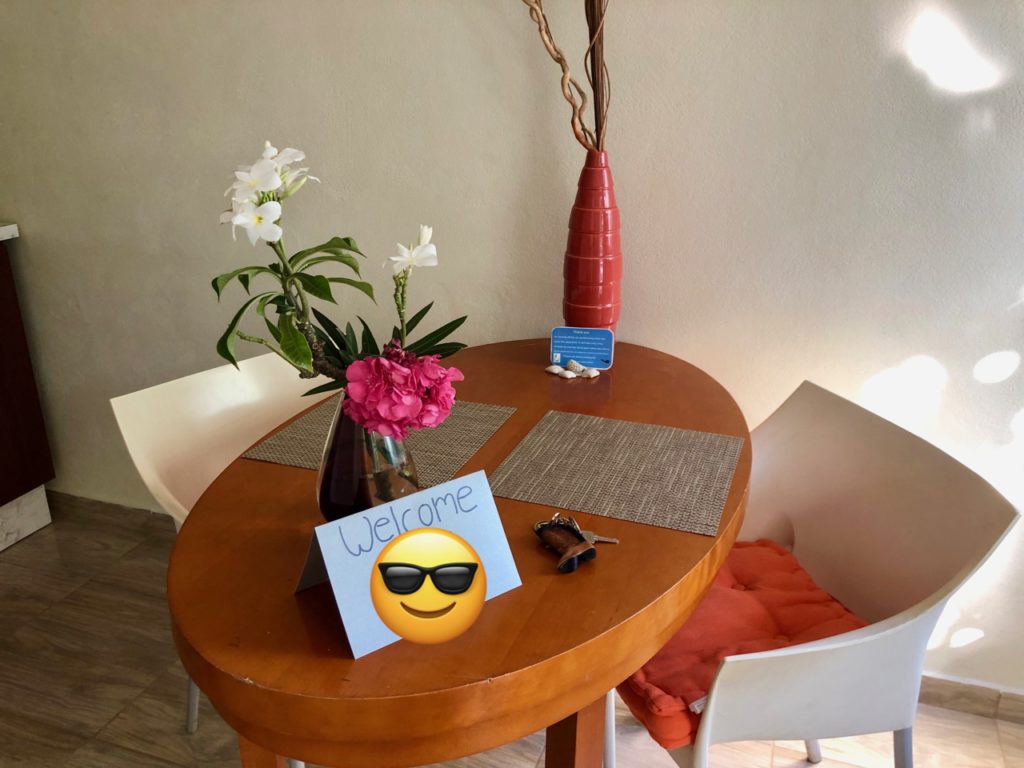
Transportation: $1.73 / person / day
(Or $52 / person / month)
Since our AirBnB was walking distance from shops, restaurants and grocery stores, we only used public transportation once to get back home from Oranjestad after the Carnaval (which is about a 60 minute walk). The city offers public buses on the entire west coast with mandatory connections at Oranjestad if you want to go from north to south. Beyond that you can take taxis, hire a car as we did for two days or book a tour. Cost for the bus is 9 AWG (or 4.40 USD) per person. Uber service is not available in Aruba. Daily rate for our car was about 42 USD. A taxi trip from Palm Beach to the airport is about 30 USD.
⇒ In total, for the length of our stay, the 2 of us spent $101.09 on transportation.
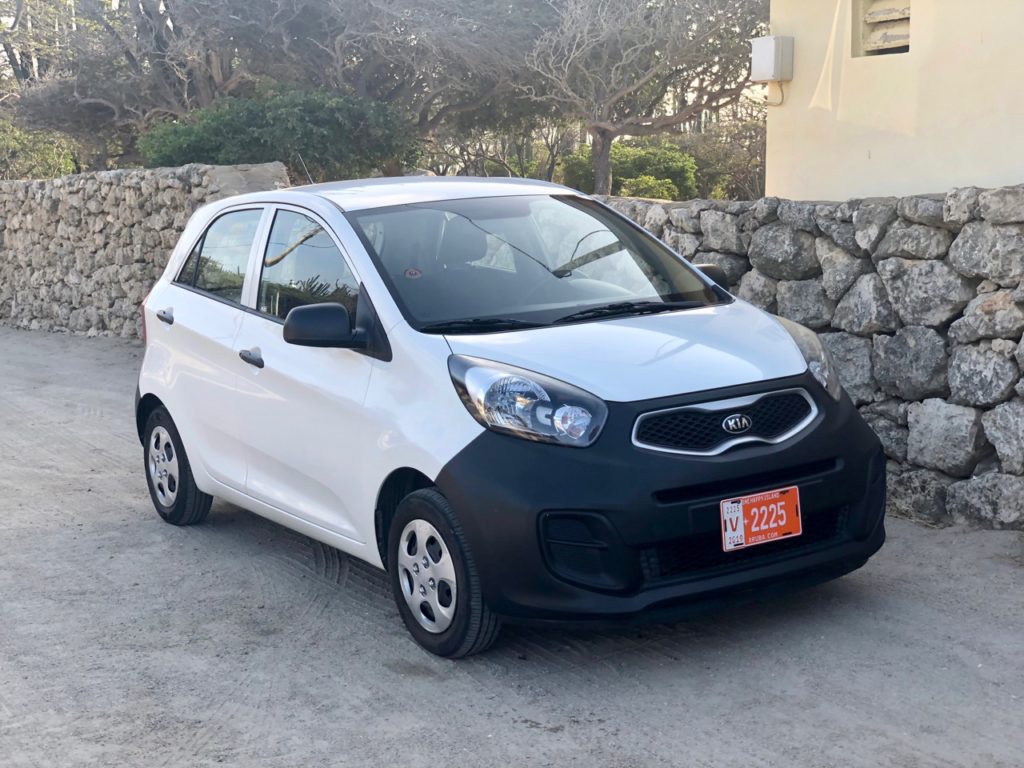
Groceries: $10.90 / person / day
(Or $327 / person / month)
We mostly went grocery shopping at Super Food where we were able to find a good selection of produce (like fruits & vegetables) but this was pretty expensive. Daily Fish was also a place we went to buy fresh fish.
⇒ In total, for the length of our say, the 2 of us spent $631.43 on groceries. This covered 84/92.5 meals (breakfast, lunch & dinner) which is about $4.18 / meal.


Eating Out: $5.30 / person / day
(Or $159 / person / month)
Aruba has hundreds of restaurants, however most of them are targeted at tourists and they are not the local cuisine. We did not eat out that much and decided instead to spend our money towards cooking some nutritious meals at home with the best ingredients we could find. When we did eat out, our favorites places to eat out were Dragonfly & Zeerovers (see our recommended restaurant section above for more details).
⇒ In total, for the length of our say, the 2 of us spent $307 on restaurants + $0 on snacks. Our restaurant budget covered 8,5/92.5 meals (mostly lunch or dinner). The average cost of our meals was $17.49 (including tax + tip) which is 3.5 times more expensive than eating at home (by doing the ratio between what a full day of eating out would cost vs a full day of eating at home as per our budget).
Activities: $1.93 / person / day (OR $58 / person / month)
Our activities in Aruba included mostly time at the beach, some swimming and reading. We saved quite a lot by waking up early and getting an umbrella and carry on foldable chairs that our hosts provided us with. (a $45 saving / day if we would have to rent them). Beside this relaxing morning routine, we did pay a visit to Arikok National Park (22 USD) and book an afternoon cruise (90 USD) for some cool snorkeling.
⇒ In total, for the length of our say, the 2 of us spent $112 on activities.
Miscellaneous: $0 / person / day
(Or $0 / person / month)
We did not have any miscellaneous expenses during this trip.
Slow Traveler Tips
Slow travel is part of our philosophy. It gives us the opportunity to really connect with a place by not having to experience FOMO (Fear Of Missing Out) and getting unnecessarily stressed for being on a schedule. With slow travel, we can see all the iconic sights and have time to spare to find the more offbeat spots that most tourists miss. Most of the time, those are the absolute gems. And as this blog post explains, we spend much less by leveraging “local” pricing and being able to leverage long stay discounts.
Here are some tips for anyone that plans to stay in Aruba:
- Aruba is windy so plan accordingly – Be aware that the wind tends to mask the strong sun on the island (hence you can burn really easily if you don’t wear appropriate sun protection). Also don’t try to keep anything on the beach as such items might fly away pretty easily. Same when you are on a cruise as Mrs. Nomad Number learned by losing her cap to the ocean.
- Read Aruba Events – This was our main source of information when it came to finding what was happening in Aruba during our stay. You can access Aruba Events here.
- Get the supermarket cards – Similar to Safeway in the US, not getting the FREE supermarket card (aka the customer rewards card) will cause you to miss out on some great savings. Just spend a few minutes to stop by the customer desk and ask!
- Use AirBnB – AirBnB is a website that allows homeowners, in destinations all over the world, the ability to rent private spaces (or entire apartments) for a fee. As nomadic long term travelers, we like to call AirBnB our home as it has helped us save a lot of money and provided us with really great places managed by wonderful hosts!
Cost of Living Tips: How to Save Money in Aruba
Here are the main ways that we saved in our cost of living in Aruba:
- We woke up early to get a FREE umbrella by the beach. Knowing that these are getting rented for about 25 USD / day, we did save quite a lot over the length of our stay. Usually you need to be by the beach before 8am to make sure you can score one.
- We walked when we felt like it. This helped reduce our carbon footprint while increasing our exercise activity. Double win!
- We use travel credit cards with sign-on bonuses to maximize free miles that we then apply towards our trip to travel for (almost) free.
- We went grocery shopping and cooked most of our meals at home instead of dining out every meal.
- We rented a family guesthouse as a longer-term stay via AirBnb instead of booking a nightly resort.
So that’s it folks! Would you be interested in going to Aruba? Is the cost of living in Aruba as affordable as you thought it was? Feel free to share your experience and ask questions by leaving a comment below.

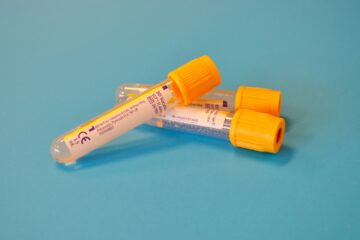

11 Comments
Dragon Gal · April 1, 2019 at 2:55 pm
I LOVE how detailed your posts are! LOVE your infographic of expenses–super! We went to Aruba a while back, but stayed in a hotel, so I was very curious about staying in an Airbnb, renting cars, and grocery shopping. Also, I was curious to see what else there was to do besides the beach and the National Park looks cool. Thanks so much for an informative post! Look forward to reading about your next slow travel adventures!
Mr. Nomad Numbers · April 1, 2019 at 3:48 pm
Thanks Dragon Gal for the comment! We put a lot of effort to share our recommendations & numbers because we want to show that slow travel can be really affordable, even if places like Aruba. If you feel comfortable sharing, can you tell us how long you stay in Aruba and what was your overall budget on the island (besides your round trip flight)?
LOVES TRAVEL · April 1, 2019 at 8:48 pm
This is a great post. What I really liked was the attention to add all the links for various places / activities. It clearly shows that you have taken great care to create this. Thanks again for showing us why slow travel is so important. It seems like a very good option.
Mr. Nomad Numbers · April 1, 2019 at 11:08 pm
Thanks Loves Travel for stopping by! I have to say that we do already track our spending for ourselves so putting it on the blog, isn’t as much work as it might seems. We also hope to be able to build a nice cost of living index once we will have visited enough places around the globe so people could hopefully realized that it isn’t that expensive to travel on the long run and that it might even be cheaper than staying at home 🙂
A Purple Life · April 2, 2019 at 12:34 am
LOVE IT! Absolutely love how detailed these reports are – and how visual (both pictures and infographics). I’m getting the travel bug just looking at this post. Thanks so much for sharing. I look forward to referencing your posts when planning my retirement travels!
Mr. Nomad Numbers · April 2, 2019 at 1:16 am
I’ve been pretty fascinated by your story that you shared with Gwen & J on the Fire Drill podcast so having you stopping by and knowing that you are enjoying our destinations reports means a lot! Here at Nomad Numbers we believe that life should be lived to its fullest potential. By sharing our nomadic journey of slow travel and being transparency about our cost of traveling the world, we hope to inspire people to think differently about the life they can design for themselves (& in our case showing that it can be much cheaper than staying at home). So feel free to share the love with you circle as the more people we can reach, the better our change to inspire people to live a better (& purple?) life 🙂
funseeker · July 11, 2024 at 8:17 pm
Price of beer and wine would be good in local bars
Mr. Nomad Numbers · July 17, 2024 at 5:01 am
Can you expand more on what you mean? Is the price cheaper in local bars than in grocery stores for instance? Or in higher end hotels?
Our origin story: how we decided to become nomads – Nomad Numbers · October 28, 2019 at 7:01 am
[…] Aruba […]
Destination Report: Koh Lanta - Part One: What to do, see, eat and avoid - Nomad Numbers · February 10, 2020 at 3:25 pm
[…] Aruba, Caribbean Sea […]
Destination Report: Koh Lanta - Part Two: Cost of Nomad Living - Nomad Numbers · March 2, 2020 at 9:17 am
[…] Aruba, Caribbean Sea […]